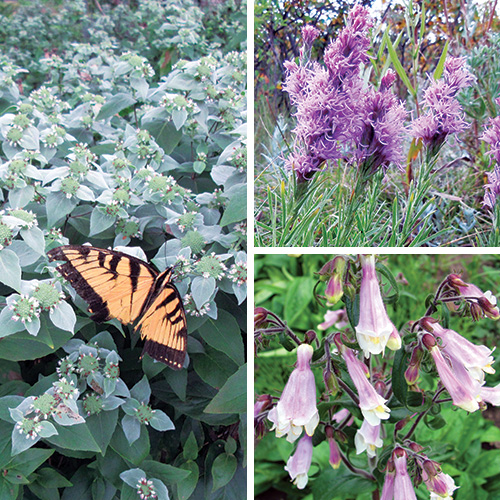In every corner of the United States, native perennials offer an unparalleled blend of beauty, resilience, and ecological harmony. In “Great Native Perennials for Your Region,” we’ve partnered with regional experts to spotlight four exceptional native plants that flourish in America’s diverse eco-regions.
From coastal plains to mountainous terrains, these carefully selected perennials not only elevate your garden’s aesthetic but also nurture local wildlife and contribute to sustainable gardening practices. Join us as we explore these unique botanical treasures and learn how they can transform your outdoor space into a vibrant, eco-friendly haven.
Pacific Northwest
Dwarf Rose Checkermallow
Name: Sidalcea malviflora subsp. virgata
Zones: 6–9
Size: 1½ to 3 feet tall and 1 to 2 feet wide
Conditions: Full sun; well-drained soil
Native range: Western United States, from Washington to California
Dainty to look at yet tough and sturdy, this perennial sports nonstop showy pink hollyhock-like blooms from spring through fall. The blossoms absolutely cover the tall upright flower stalks. Dwarf rose checkermallow is a charming vertical accent in any sunny border or container. It’s also fabulous in a cutting garden and is a pollinator magnet. Rich green scalloped leaves form an attractive compact mound and make a lovely backdrop for the bloom display. Although it prefers full sun and well-drained soil, you’ll want to water this plant lightly but regularly during especially dry periods and deadhead frequently to ensure repeat flowering. Dwarf rose checkermallow is herbaceous but returns stronger and increasingly floriferous each year.
‘Russian River’ Coyote Mint
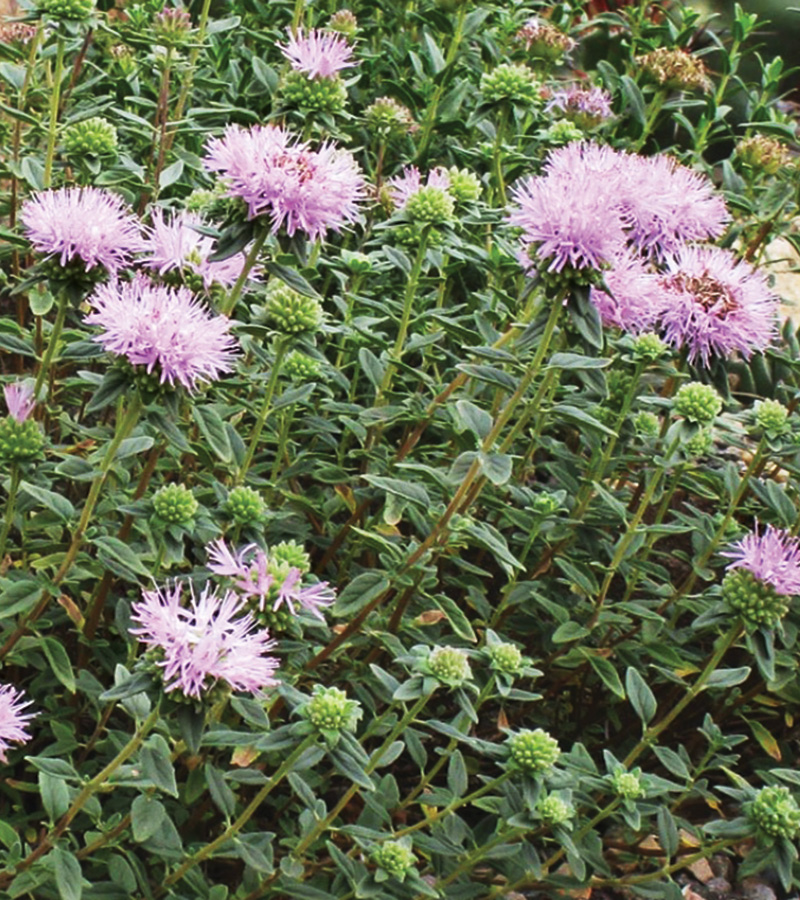
Name: Monardella villosa ‘Russian River’
Zones: 6–9
Size: 12 to 18 inches tall and 15 to 18 inches wide
Conditions: Full sun; well-drained soil
Native range: Southern Oregon and Northern California
This compact, mounding, fragrant-foliaged native hails from the rocky shores of Sonoma County’s own Russian River. Tough, deer and gopher resistant, and drought tolerant too, this mint-scented evergreen perennial blooms from late spring to fall. Its fluffy puffball clusters of rich lavender-colored blooms are adored by bees and butterflies alike. Wonderful for dry perennial beds or rock gardens, ‘Russian River’ coyote mint is the perfect plant for growing under native oak trees (Quercus spp. and cvs., Zones 3–10). Full sun exposure is fine by the coast or in cooler regions, but afternoon shade is important if you’re growing this plant in a hotter inland location. Shear it back by one-third in late winter to refresh the plant.
‘Wayne Roderick’ Seaside Daisy
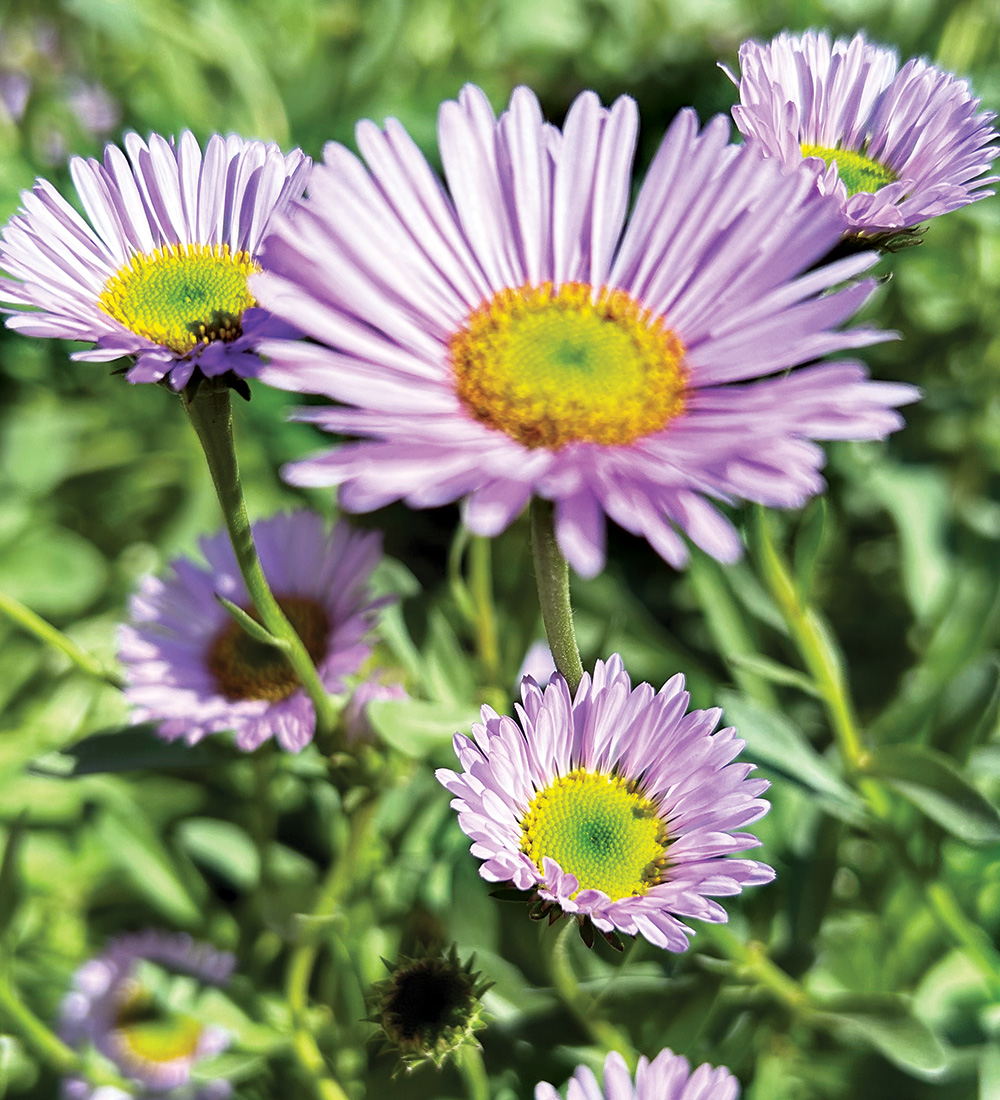
Name: Erigeron glaucus ‘Wayne Roderick’
Zones: 6–10
Size: 10 inches tall and 2 feet wide
Conditions: Full sun to partial shade; fertile, moist, well-drained soil
Native range: Coastal Oregon and Northern California
The carpet-like mound of soft, blue-green foliage of this perennial almost disappears under masses of big (1-inch diameter) golden-centered, lavender-blue daisies in spring, summer, and fall. In fact, if deadheaded frequently (or sheared back by half in summer), this plant is almost always in bloom, much to the delight of a host of native bees. ‘Wayne Roderick’ seaside daisy is a low-maintenance beauty that is drought tolerant once established. It is happiest in coastal gardens or sheltered from the hottest afternoon sun in inland areas, and works beautifully in mixed borders, meadows, or containers. Fabulous when massed or edging a walkway, this native is tolerant of all kinds of soils, deer, gophers, and even sea spray.
Fringecups
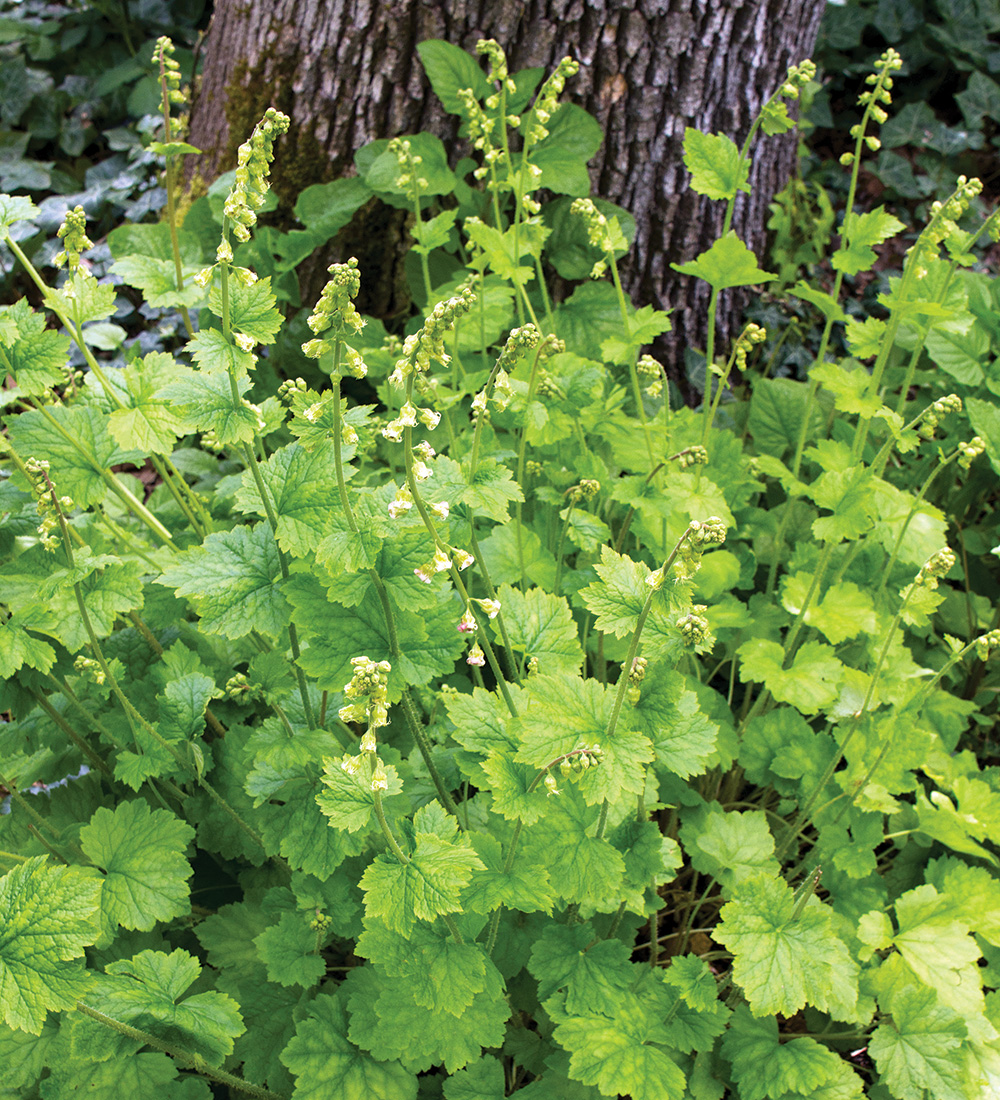
Name: Tellima grandiflora
Zones: 4–9
Size: 8 inches tall and 10 inches wide
Conditions: Partial to full shade; humus-rich, moist soil
Native range: Alaska, California, Idaho, Montana, Oregon, Washington, Alberta, and British Columbia
If you’re looking for year-round interest in the shade garden, look no further! In summer, the broad green scalloped leaves of fringecups are interesting but become particularly stunning in fall and winter, when colder temperatures highlight the foliage with crimson, bronze, and purple hues. Tall spikes bearing petite fringed chartreuse flowers appear in spring. These gradually fade to pink and are delightful in floral arrangements whenever they’re picked. You’ll find native populations of this plant growing along the stream banks and damp forest floors of the Pacific Northwest. Fringecups is 8 inches tall when not in bloom but tops 28 inches tall when flowering.
Regional expert: Fionuala Campion has gardened along the West Coast of the United States for over 30 years. She is the owner/manager of Cottage Gardens of Petaluma and a Pacific Northwest regional reporter for FineGardening.com.
Southwest
Prairie Verbena
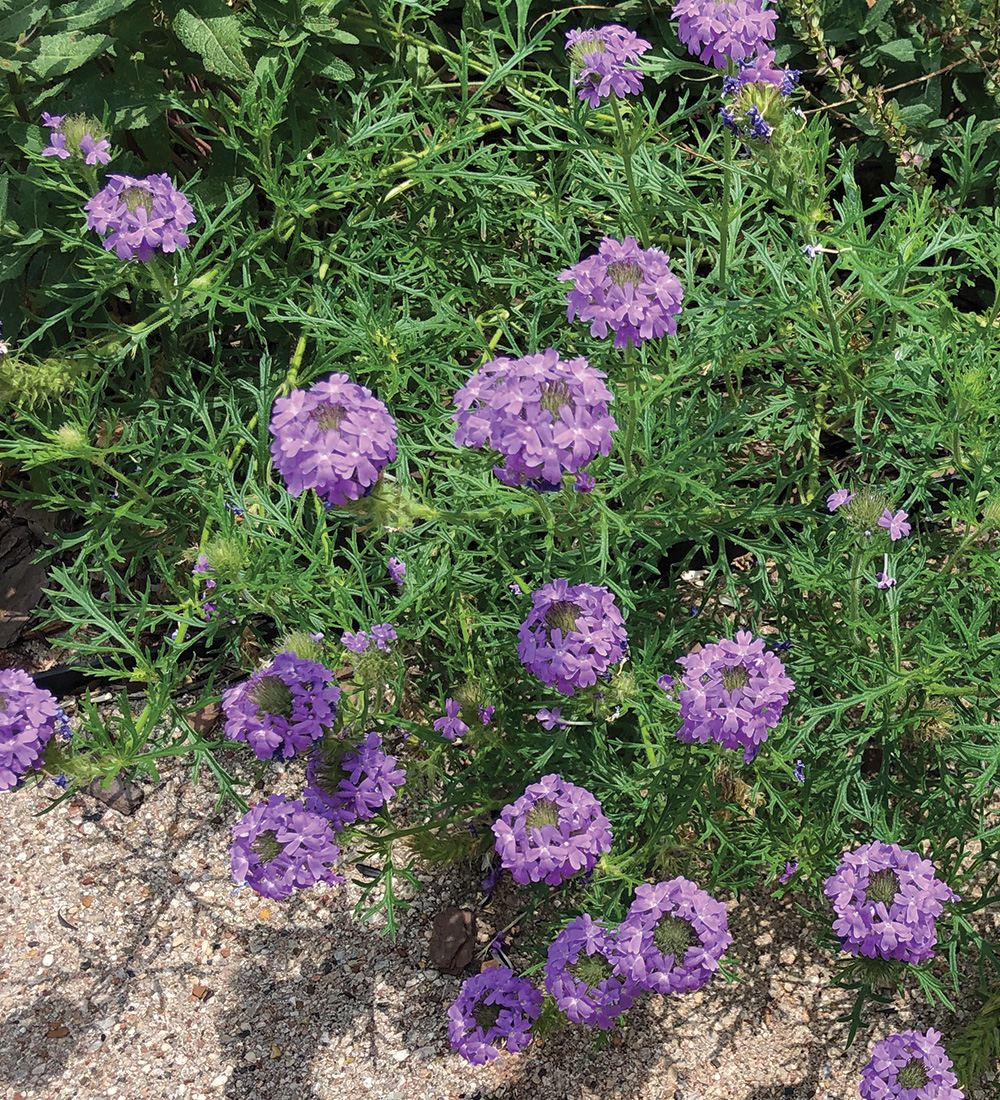
Name: Glandularia bipinnatifida
Zones: 5–9
Size: 6 to 12 inches tall and 18 to 30 inches wide
Conditions: Full sun to partial shade; well-drained soil
Native range: Southern United States and Northern Mexico
This trailing beauty blooms with abandon from March through October in my Oklahoma garden, carpeting the ground with rounded clusters of brilliant purple to pink blooms. The sweetly fragrant flowers draw scores of bees and butterflies, while the deeply lobed foliage adds fine texture to plantings. Prairie verbena may look delicate, but it is a hardy plant, tolerant of drought, heat, and deer. I’ve found plants bloom best in full sun, though they can take some shade. There is no need for deadheading spent blooms, as this perennial continues to produce new flowers regardless. Prairie verbena looks lovely scrambling through any dry garden.
Dotted Blazing Star
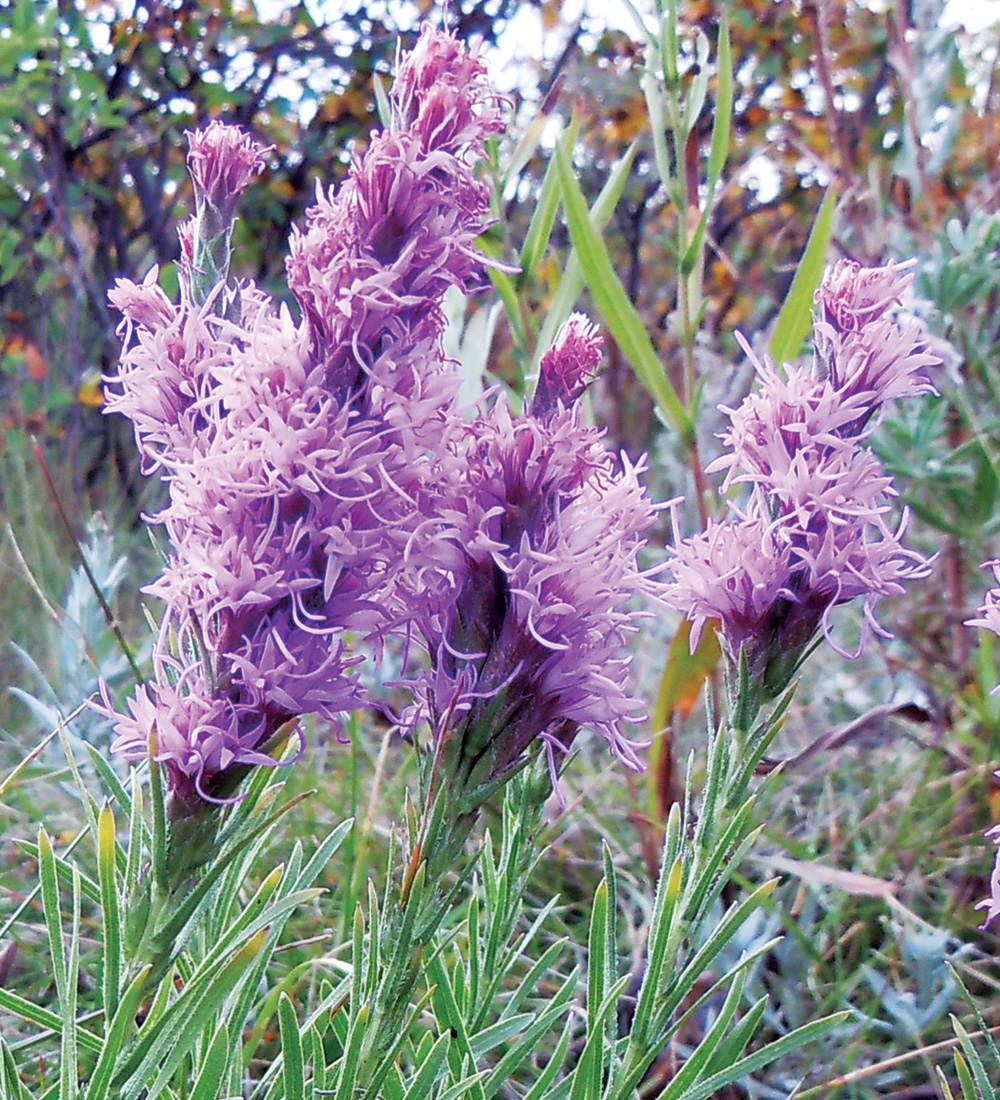
Name: Liatris punctata
Zones: 3–9
Size: 12 to 24 inches tall and 8 to 12 inches wide
Conditions: Full sun; dry to medium, lean, well-drained soil
Native range: Manitoba and Saskatchewan, south to Texas and Arizona
A long taproot makes dotted blazing star the most drought tolerant of the Liatris species, yet its flowers and foliage are no less radiant. Long wands of densely packed lavender-rose blooms appear in late summer through fall atop upright stems and fine-textured foliage. The blossoms make excellent cut flowers and retain their color well when dried, if harvested early in the bloom cycle. To encourage a bushier habit, cut plants back at the start of the growing season. Dotted blazing star needs loose, well-drained soil such as sand, loam, or gravel, and tolerates alkaline and calcareous soils. Moist, fertile soil can cause plants to flop. This perennial also performs beautifully in containers.
Gregg’s Blue Mistflower
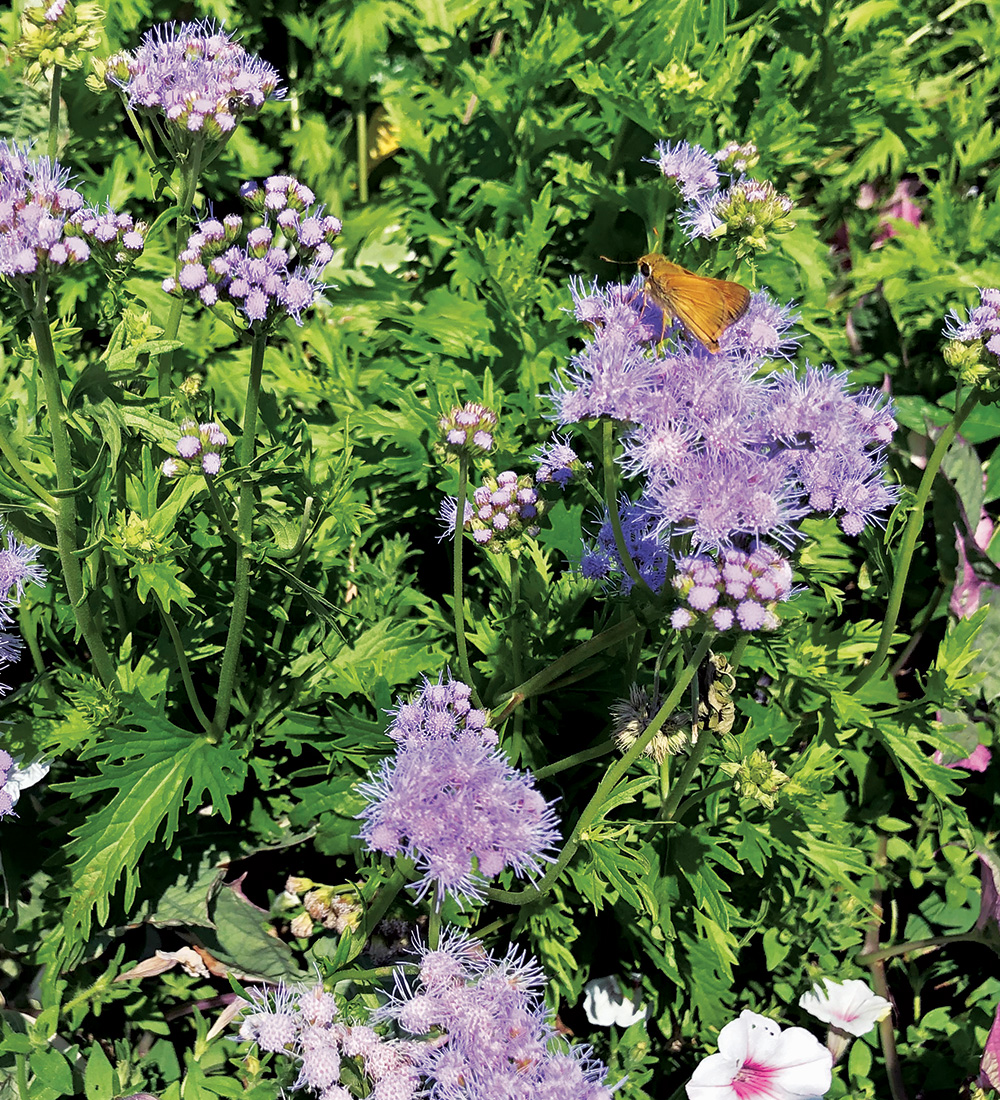
Name: Conoclinium greggii
Zones: 7–10
Size: 1 to 2 feet tall and wide
Conditions: Full sun to partial shade; dry to medium, well-drained soil
Native range: Texas, New Mexico, Arizona, and northern Mexico
In fall, migrating monarch butterflies flock to the powdery blue, ageratum-like blooms of Gregg’s blue mistflower on their journey south. The nectar-rich blossoms also attract an abundance of queen butterflies, a close relative of monarchs that have a special connection to mistflower. The plant produces a chemical that queen butterflies use to produce mating pheromones and protect eggs from predation. As you might expect, this plant blooms profusely in autumn, beginning midsummer and continuing until winter freezes it back. With light green, finely sculpted foliage, Gregg’s blue mistflower makes a lovely upright ground cover or filler. Plants spread via rhizomes and can be rambunctious under optimal conditions.
Fameflower
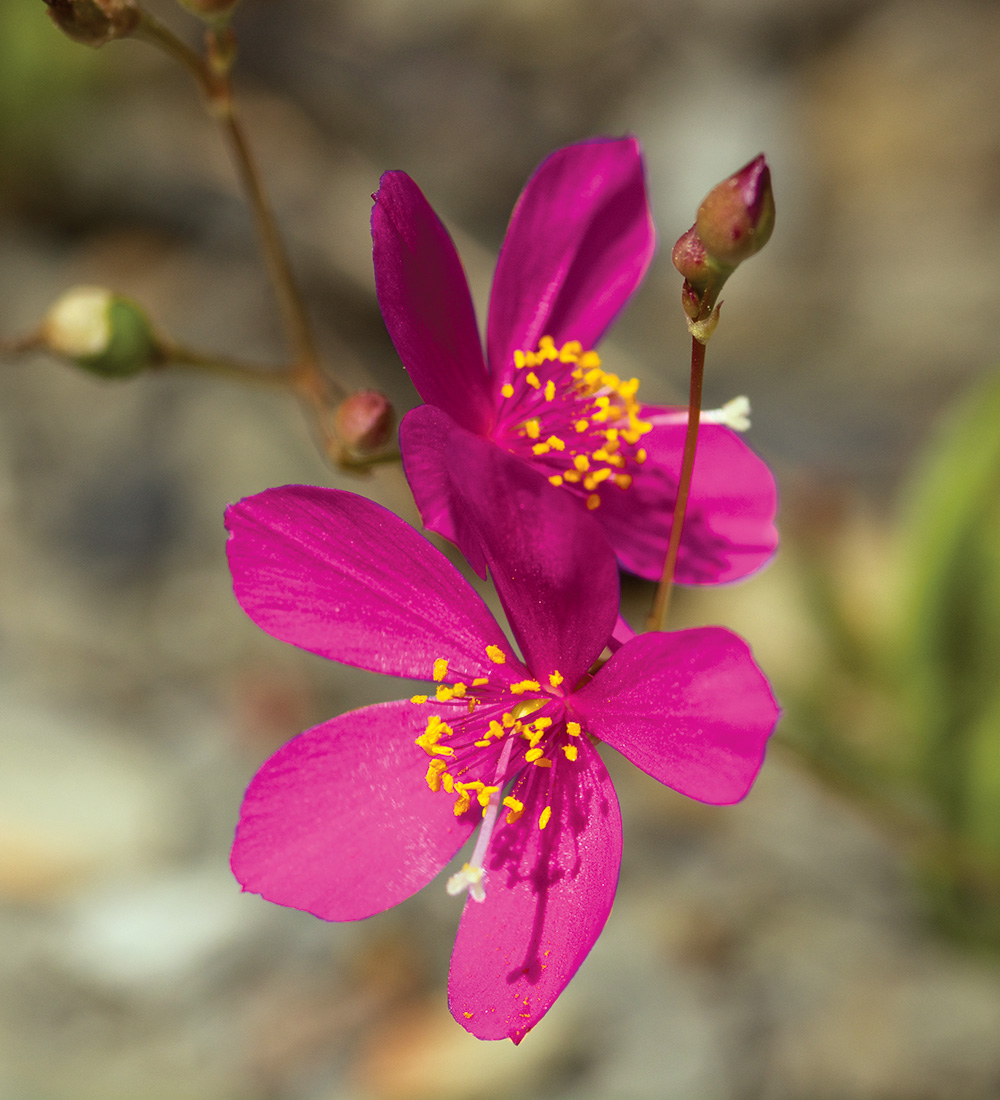
Name: Phemeranthus calycinum (syn. Talinum calycinum)
Zones: 5–9
Size: 6 to 10 inches tall and 6 to 12 inches wide
Conditions: Full sun; dry to medium, well-drained soil
Native range: Central southern United States
Native to rocky or sandy locales, fameflower is adored for its succulent foliage and vibrant magenta-pink blooms. The quarter-size flowers of this Portulaca relative open in the afternoon and stand atop thin stems that wave gently in the breeze. The narrow linear foliage stores water to help the plant cope with periods of drought. Plant fameflower on hot and sunny sites or in shallow soils where other plants struggle. It makes an excellent addition to rock gardens, xeric plantings, and dry perennial beds. Fameflower also tolerates extreme planting locations, including roof gardens, and is a real problem solver for containers in exposed locations. Look for this unusual succulent at specialty nurseries, where it may also be sold under the name rock pink.
Regional expert: Kim Toscano is a horticulturist, entomologist, and garden designer. She previously hosted Oklahoma Gardening, a weekly PBS television program produced by the Oklahoma Cooperative Extension Service.
Mountain West
Scott’s Sugarbowl Clematis
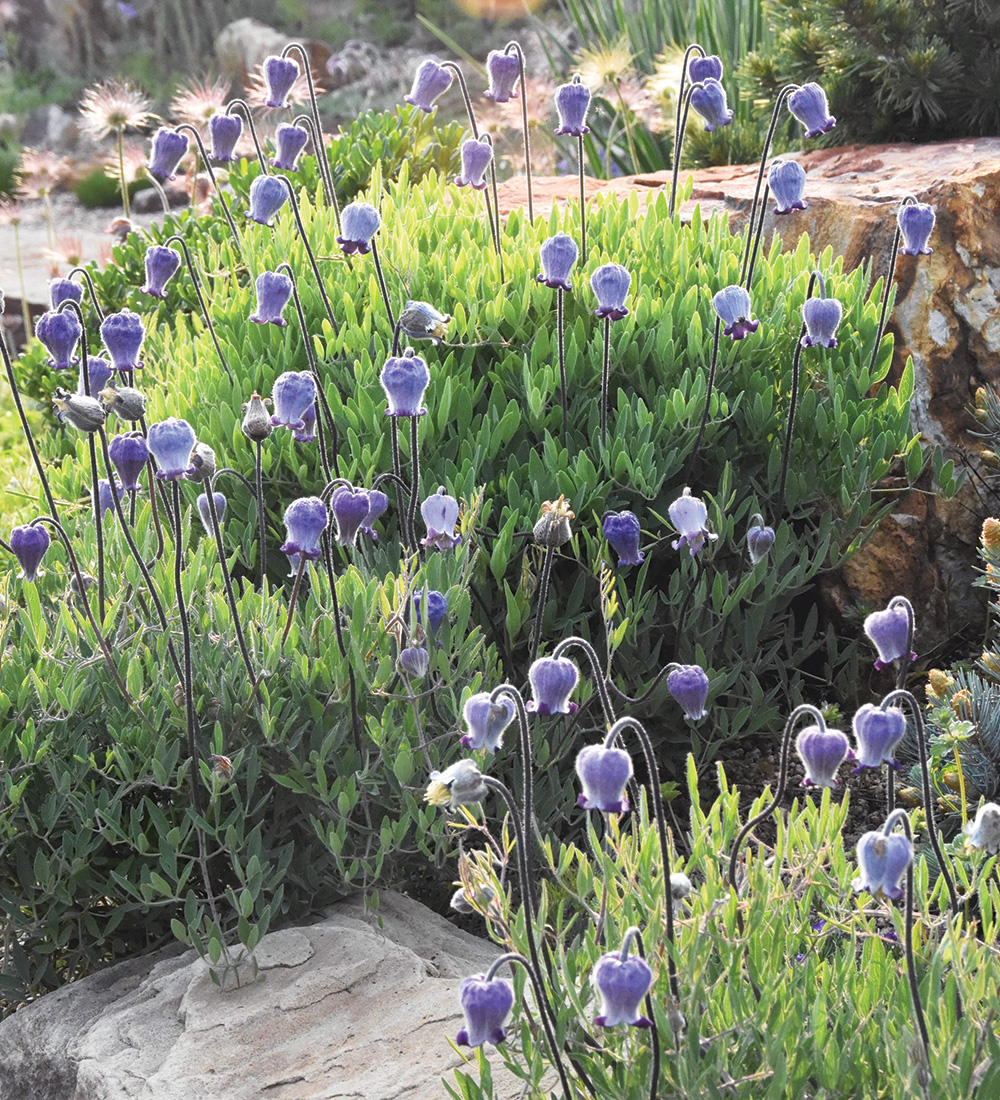
Name: Clematis hirsutissima var. scottii
Zones: 3–8
Size: 12 to 18 inches tall and wide
Conditions: Full sun to partial shade; well-drained soil
Native range: Southern Rocky Mountains
When most gardeners read “clematis,” they think of vigorous vining plants bearing soft four-petaled flowers that frequently adorn arbors and ramble across picket fences. While this unorthodox clematis still features the characteristic deep purple flowers expected from the genus, it keeps a tight and upright form. Scott’s sugarbowl clematis springs up quickly after the snow melts to form rich green mounds of finely cut foliage. It blooms shortly thereafter, sporting velvety, royal purple flowers by mid-spring. Each bell-shaped blossom nods, opening only at its tip, creating a demure display that belies the tough nature of this species. Whimsically tufted seed heads follow, clinging to dark, slender stems, and are one of the best attributes of this plant.
Santa Fe Phlox

Name: Phlox nana
Zones: 4–8
Size: 8 to 12 inches tall and up to 2 feet wide
Conditions: Full sun; well-drained soil
Native range: Mexico to New Mexico, and the southern Rocky Mountains
Of all the native plants I grow, few flower as much as Santa Fe phlox. This species begins to bloom with a spectacular flush of saturated pink, five-petaled, delightfully fragrant flowers in late spring. While its form and foliage aren’t much to write home about, with leaves and twigs that tend to blend together visually, they aren’t really the point. As long as this plant receives occasional moisture, it will continue to bloom—hitting a notable second stride during late summer—until hard frosts force it into dormancy. Santa Fe phlox is adaptable and persistent once established, only pausing its flowering to conserve resources during dry times. Though it can be slow to start, this perennial will eventually form loose, low-growing colonies with time.
Bridges’ Penstemon
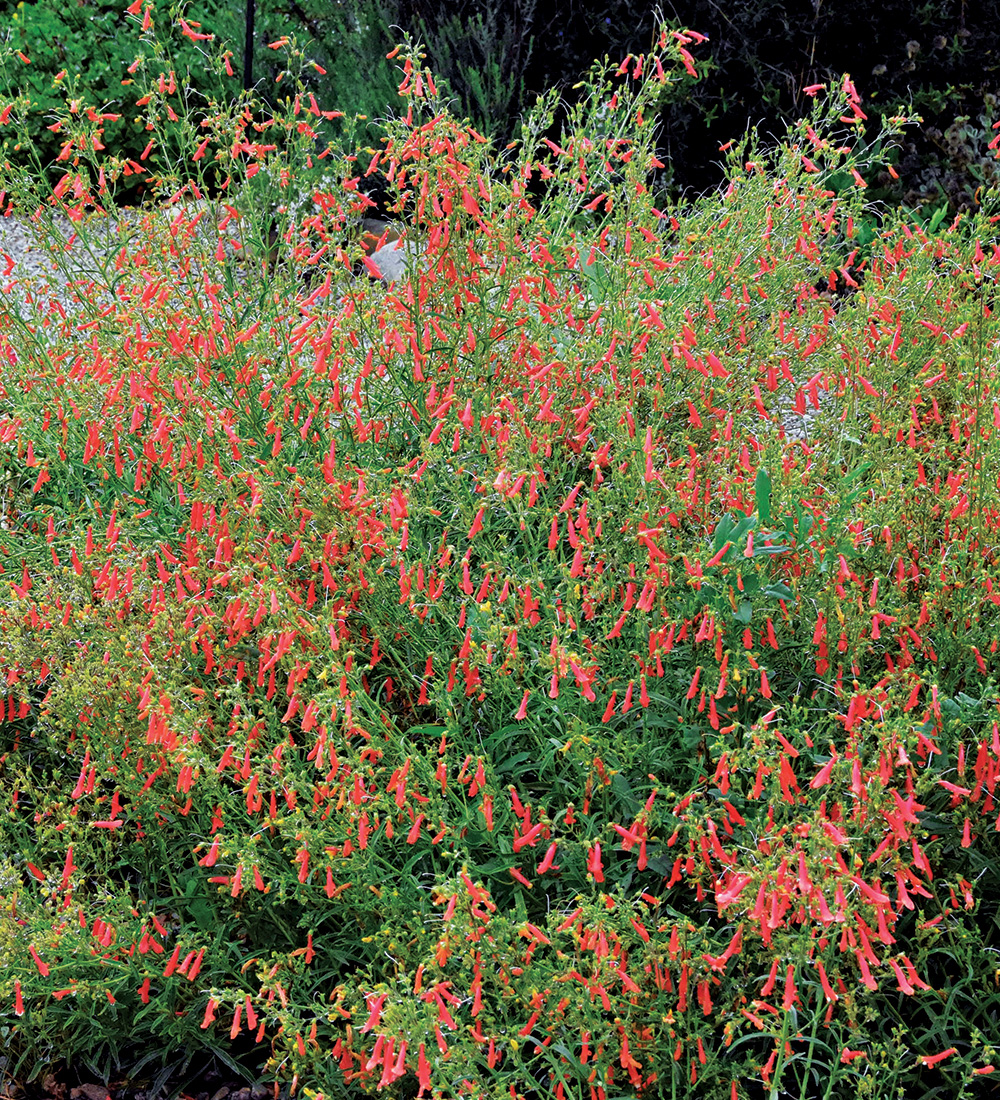
Name: Penstemon rostriflorus
Zones: 4–8
Size: 2 to 3 feet tall and wide
Conditions: Full sun; well-drained soil
Native range: Four Corners area to the Great Basin, and Southern California
Penstemons are among our region’s most iconic and desired garden plants, but they often come with an Achilles’ heel in the form of painfully short lifespans in a garden setting. Bridges’ penstemon bucks this trend and routinely lives over 5 years—sometimes as long as 10. The trick is to site it in a warm, dry spot and provide it with either gravel mulch or no mulch at all. This plant is built like a subshrub, forming short, woody branches to make a relatively small, above-ground scaffold that is covered in slender, glossy dark green leaves. Bright orange-red flowers appear midsummer en masse, enticing hummingbirds to regularly visit the tube-shaped, nectar-rich blooms. Best of all, Bridges’ penstemon requires only modest watering to continue blooming until frost.
Broom Snakeweed
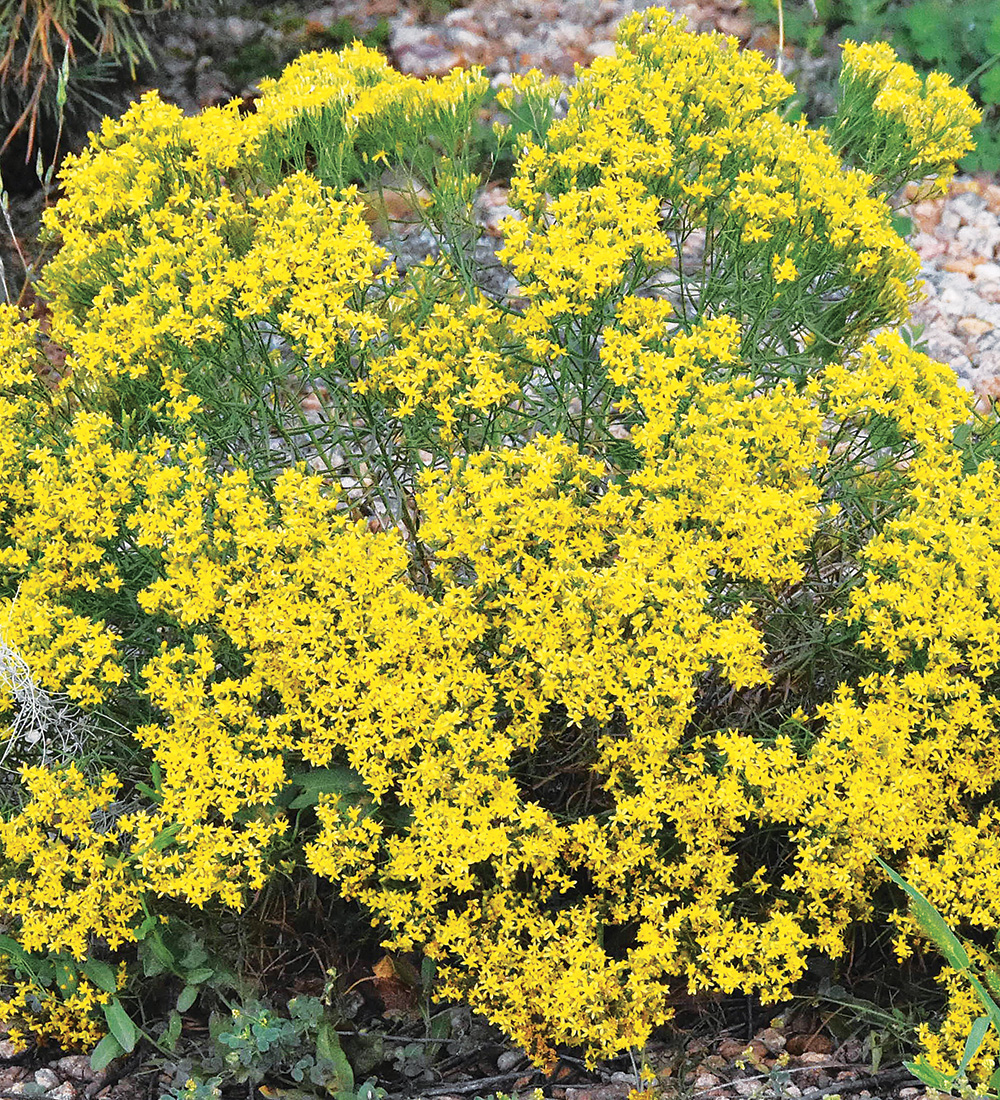
Name: Gutierrezia sarothrae
Zones: 3–8
Size: 18 inches tall and 12 inches wide
Conditions: Full sun; well-drained soil
Native range: Great Plains to the Great Basin, and Mexico to Canada
Found in grasslands, shrublands, foothills, and rocky places across the West, broom snakeweed is often mistaken for rabbitbrush (Chrysothamnus spp. and cvs., Zones 3–8), but it makes a far better addition to our gardens than its much larger cousins. Unlike rabbitbrush, broom snakeweed puts on a show with virtually no watering, and it blooms for several weeks but does so without any problematic seediness. It forms an understated dense mound of upright, broom-like stems bearing deep green leaves with rich gold flowers that appear in late summer and fall. The flower buds are a near-chartreuse color and last as long as two weeks.
Regional expert: Bryan Fischer serves as plant collection curator at The Gardens on Spring Creek in Fort Collins, Colorado. He is also the Mountain West regional reporter for FineGardening.com.
Midwest
Northern Maidenhair Fern
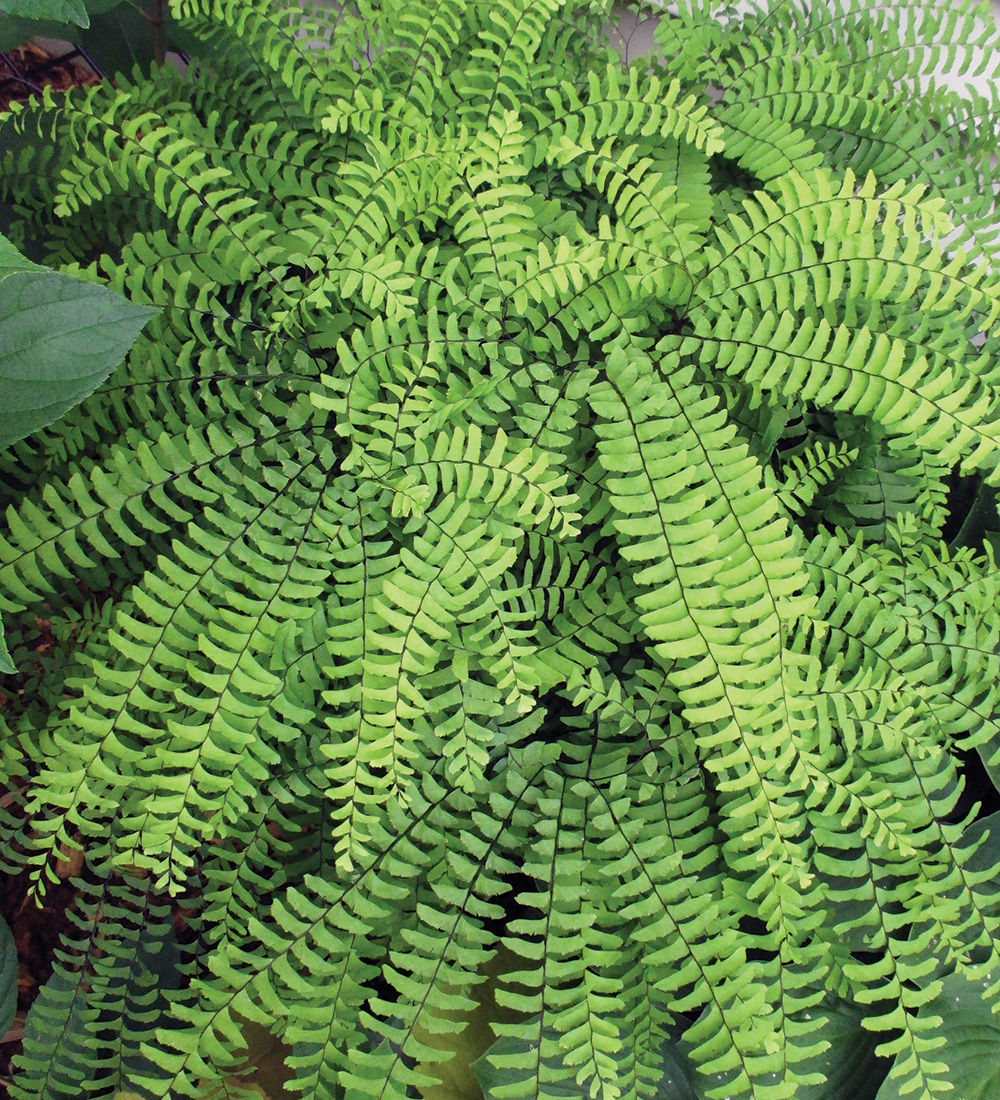
Name: Adiantum pedatum
Zones: 3–8
Size: 1 to 2 feet tall and wide
Conditions: Partial to full shade; moist, rich, well-drained soil
Native range: Eastern North America and eastern Asia
Despite its delicate appearance, northern maidenhair fern is robust and hardy. As it settles into preferred locations, it will spread slowly to form a graceful display of fanlike fronds arranged in layered, horizontal platforms that radiate from dark, curved stalks. This clump-forming native fern prefers rich, woodsy soil and requires at least some shade. Meet those requirements and it will gradually build a textural display that contributes plenty of interest in any shady situation. This medium-sized beauty combines well with literally every other shade plant; it has limitless design potential, whether you are siting solitary specimens or massing it in larger groupings.
Purple Poppy Mallow
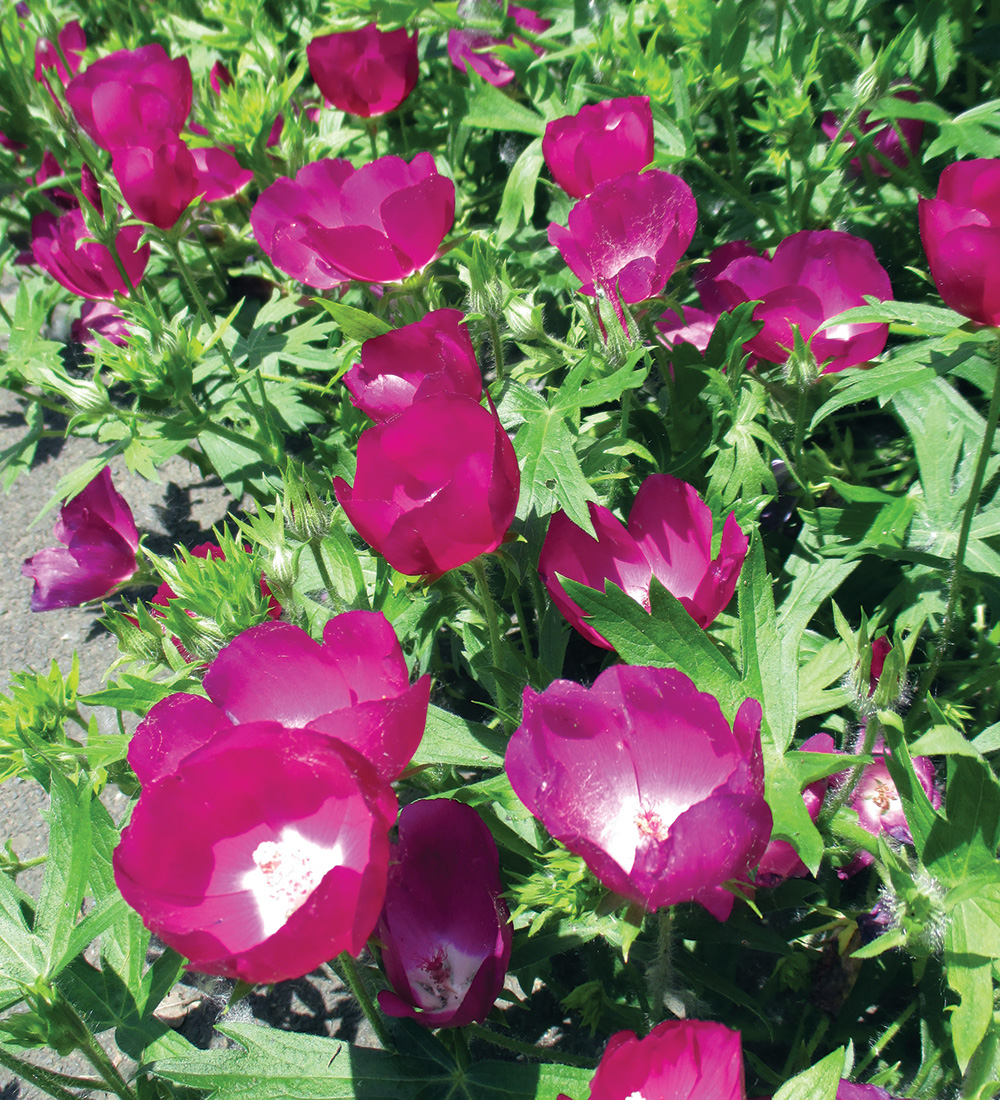
Name: Callirhoe involucrata
Zones: 4–8
Size: 9 inches tall and 36 inches wide
Conditions: Full sun; dry to moderately moist, well-drained soil
Native range: Central United States
I can’t list many perennials that bloom for months on end, but this drought-tolerant member of the mallow family is one of them. It is an excellent ground-hugging plant that stays under a foot tall but can eventually spread to form patches up to 5 feet wide. The vigorous stems feature dark green, palmately lobed leaves. The wow factor comes from the vivid cerise-magenta, chalice-shaped flowers that appear from mid-spring through fall. These upward-facing blooms reliably attract bees and butterflies. Purple poppy mallow is long-lived when given space to ramble, scramble, and spill, and it is also adaptable to a wide range of soil types. However, it does not transplant readily, due to its deep taproot.
Prairie Smoke
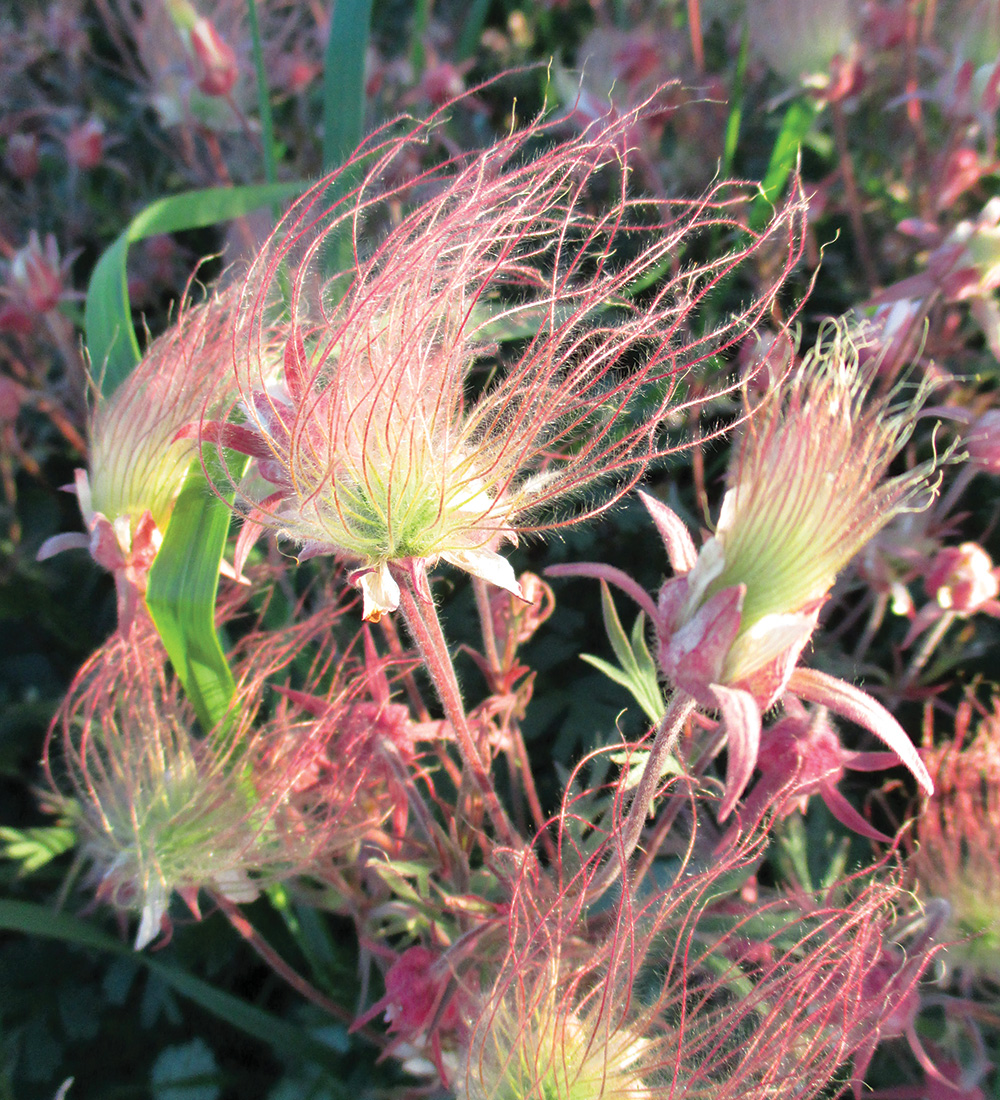
Name: Geum triflorum
Zones: 3–7
Size: 10 to 18 inches tall and 12 to 18 inches wide
Conditions: Full sun; average to dry, well-drained soil
Native range: Western North America
It is well worth crouching at ground level to fully enjoy the charms of this diminutive denizen of prairies and open woodlands. While I appreciate the reddish-pink nodding flowers that emerge in clusters of three each spring, the distinctive single-seeded achenes that form after fertilization are simply magical. These silky, silvery-pink seed heads wave in the slightest breeze, and the ferny, deeply cut foliage is nice too. The plants often have lovely late fall color that ranges from purple or red to orange. Adaptable to many soil textures, this deer-resistant plant requires excellent drainage. It prefers full sun but will tolerate a bit of shade.
Blunt Mountain Mint
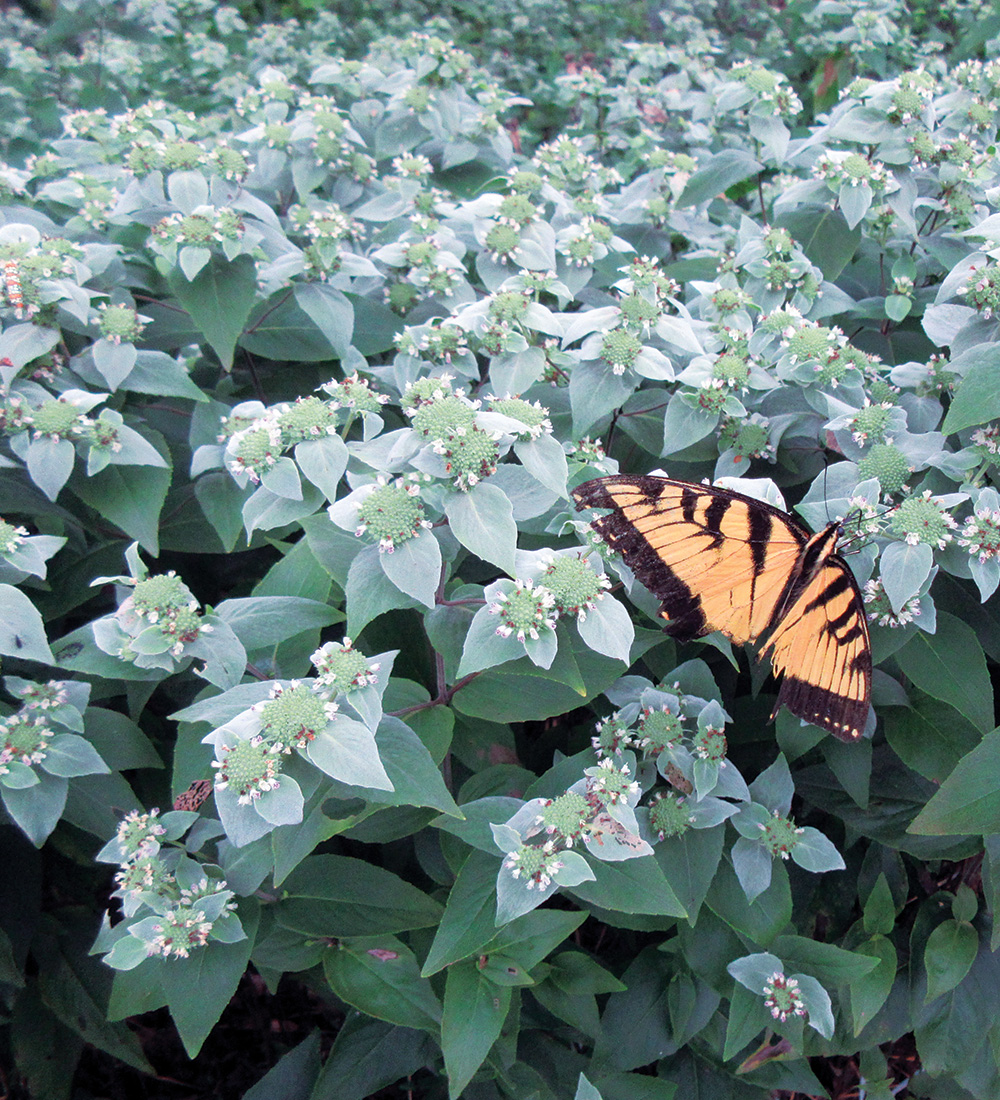
Name: Pycnanthemum muticum
Zones: 4–8
Size: 1 to 3 feet tall and wide
Conditions: Full sun to partial shade; moist to wet, fertile, well-drained soil
Native range: Eastern North America
The fact that the Perennial Plant Association (PPA) chose blunt mountain mint as their plant of the year for 2025 should get all gardeners interested in this amazing pollinator magnet. Growing up to 3 feet tall, it will take up some real estate; keep it under control by cutting back its slow-spreading, shallow rhizomes as needed. The peppermint-scented foliage is topped with a layer of showy bracts that add a silvery sheen just beneath the flowers. Abundant clusters of tubular, nectar-rich blooms attract a diverse and robust range of pollinators during the summer months. It is deer and rabbit resistant, and commonly listed as a must-have perennial for pollinator-friendly gardens.
Regional expert: Mark Dwyer is the garden manager for the Edgerton Hospital Healing Garden in Edgerton, Wisconsin, and operates Landscape Prescriptions by MD. He is also a Midwest regional reporter for FineGardening.com.
Southeast
Nuttall’s Rayless Goldenrod

Name: Bigelowia nuttallii
Zones: 5–9
Size: 12 to 15 inches tall and 8 to 12 inches wide
Conditions: Full sun; dry to medium, well-drained soil
Native range: Southeastern United States
Nuttall’s rayless goldenrod has quickly become one of my favorite underrated U.S. native plants. It’s nothing like you’d expect, starting with the fact that it’s not a true goldenrod. It looks like an ordinary tuft of grass until late summer to mid-fall, when it jumps up with dense, showy clusters of golden flowers. At no more than 15 inches tall in bloom, this perennial is ideal for tucking into rock crevices and between taller plants in persistently dry, hot, sunny areas. It pairs nicely with other drought-tolerant natives like blazing star (Liatris spp. and cvs., Zones 3–9) and baptisia (Baptisia spp. and cvs., Zones 3–9) in summer, and later provides a nice splash of evergreen interest during their winter dormancy.
Partridgeberry
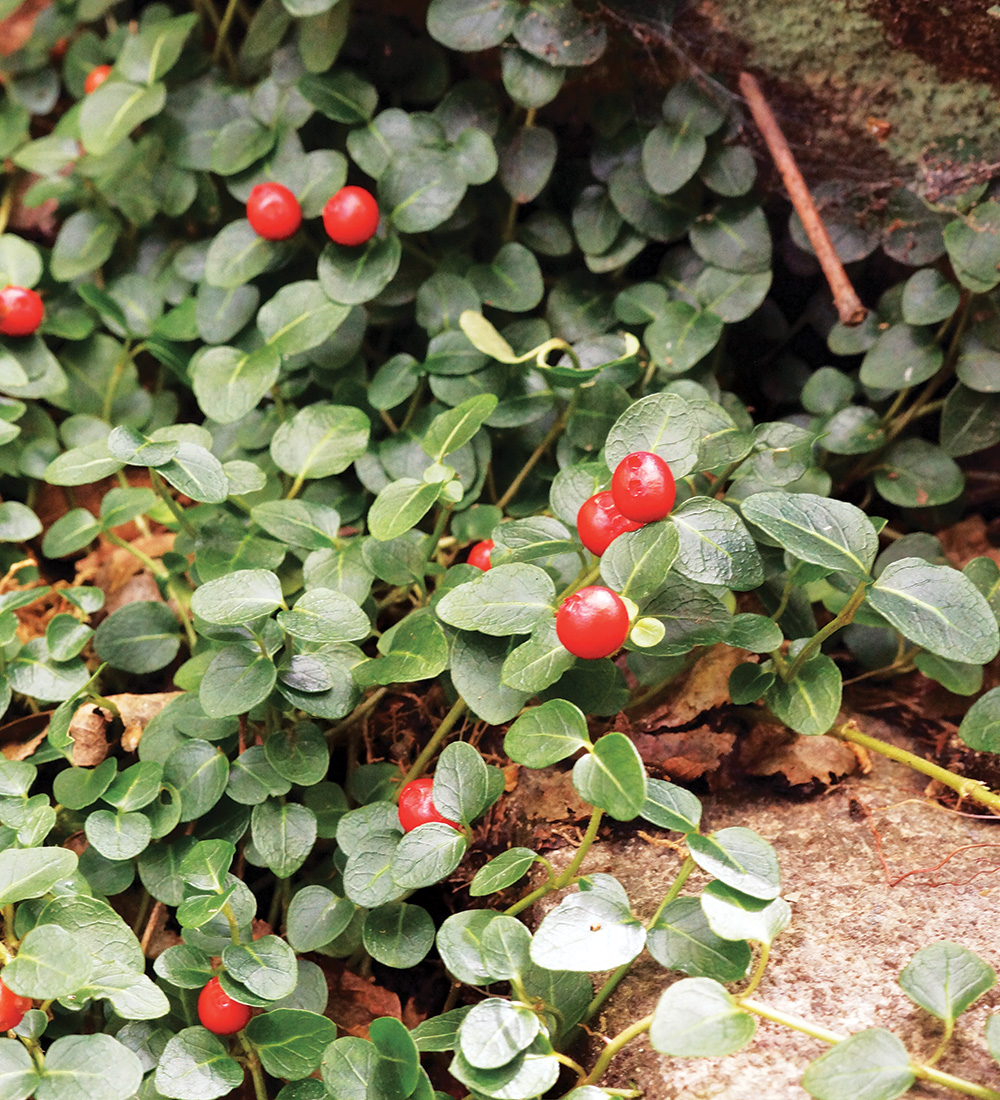
Name: Mitchella repens
Zones: 3–8
Size: 2 inches tall and 8 to 12 inches wide
Conditions: Partial to full shade; medium to moist, well-drained soil
Native range: Eastern North America
Everyone loves an underdog, and this native evergreen ground cover certainly qualifies. To be clear, partridgeberry isn’t the type of ground cover that will replace a lawn or crowd out weeds—quite the opposite. It’s a slow-growing, dainty perennial that can easily be bullied by more aggressive spreaders. It’s ideal for planting in acidic soil beneath trees or shrubs where other plants may struggle, so it can meander in peace into a lovely green latticework. If that isn’t endearing enough, the true benefit of partridgeberry lies in its value to wildlife. Its fragrant white flowers in late spring and early summer are followed by bright red berries, which are favored among songbirds, small mammals, and even larger birds like quail and turkeys.
Spotted Beebalm
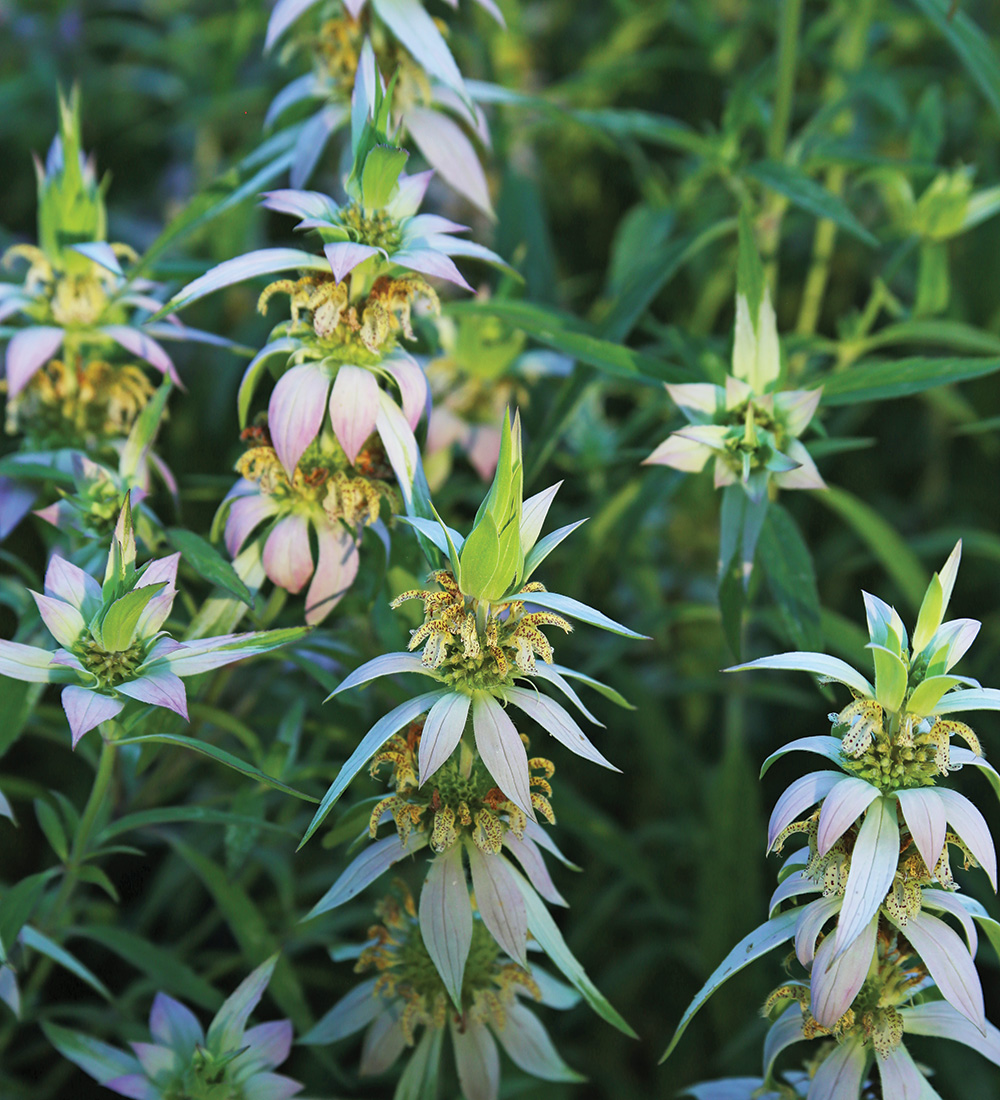
Name: Monarda punctata
Zones: 3–8
Size: 1 to 3 feet tall and 1 to 2 feet wide
Conditions: Full sun to partial shade; dry to medium, well-drained soil
Native range: Eastern and south central North America
This showy species of bee balm is well worth planting in a pollinator garden. The actual flowers are small, yellow, and spotted, and don’t provide very much interest (unless you’re a bee). The beautiful bracts, however, are large, white to pink in color, and last for much longer than the blooms. They appear in tiers on each flower stalk for a lovely summer display. Spotted bee balm is a host to several native insects, including the gray marvel moth and raspberry pyrausta moth. As you would with other bee balms, you should be careful not to fertilize it or plant it in overly rich soil, because it will become leggy. If it starts to look tired after blooming, just cut it back so it can regrow with fresh foliage.
Blue Sage
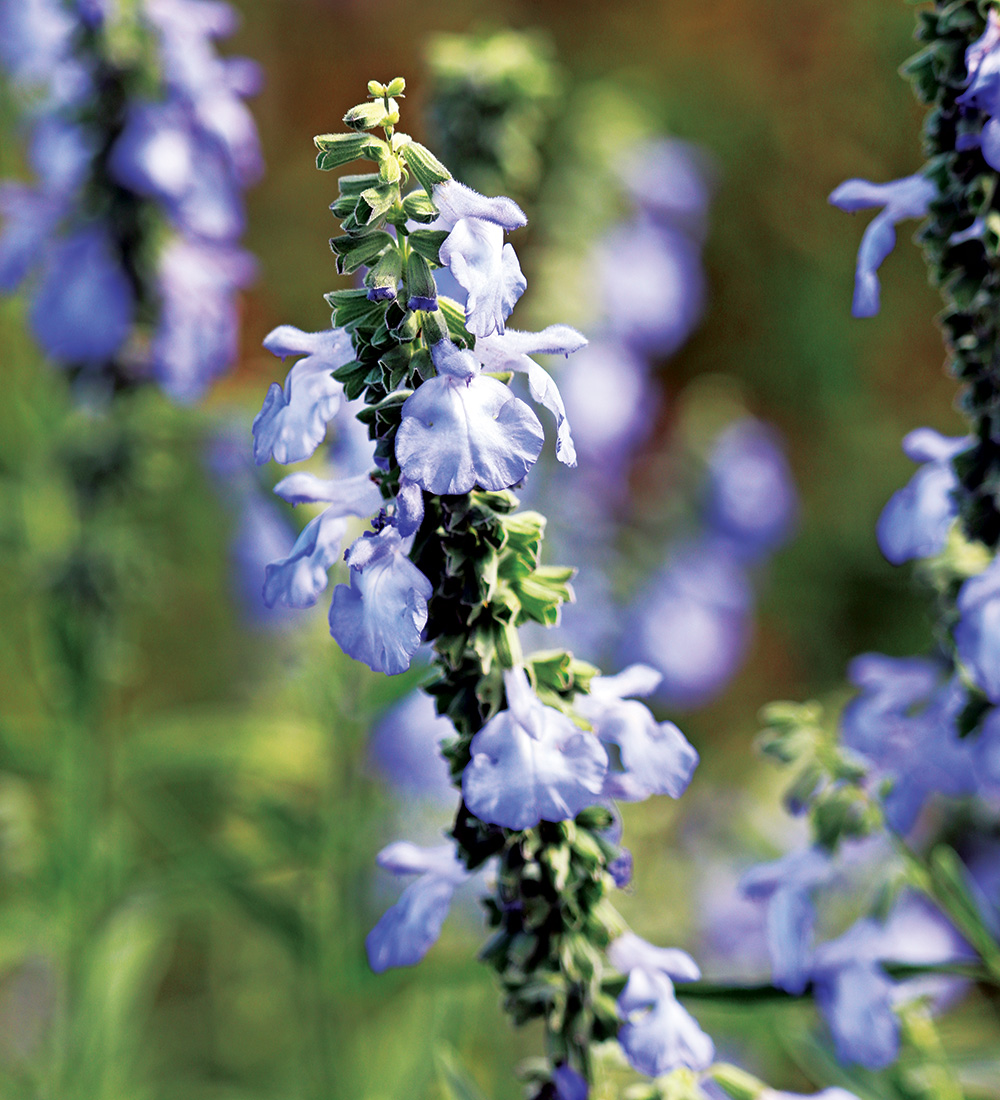
Name: Salvia azurea
Zones: 5–9
Size: 3 to 5 feet tall and 2 to 4 feet wide
Conditions: Full sun to partial shade; dry to moist, well-drained soil
Native range: Eastern and central United States
Blue is one of the rarest colors to find in nature, which makes this native perennial all the more special. It holds immense value for insects, both as a nectar plant when blooming from summer into late fall, and as a host plant for the hermit sphinx moth. It emits a mild fragrance when crushed, which is enough to deter deer and rabbits. Azure blue sage is a lovely candidate for meadow gardens and pairs well with native grasses. In more formal settings, cut it back by half its height in spring to encourage a more compact habit. It should not be fertilized, as that may cause it to flop over.
Regional expert: Cheyenne Wine is a gardener with experience in plant nurseries. She works with the Virginia Department of Conservation and Recreation and is a regional reporter for FineGardening.com.
Mid-Atlantic
Eastern Bluestar
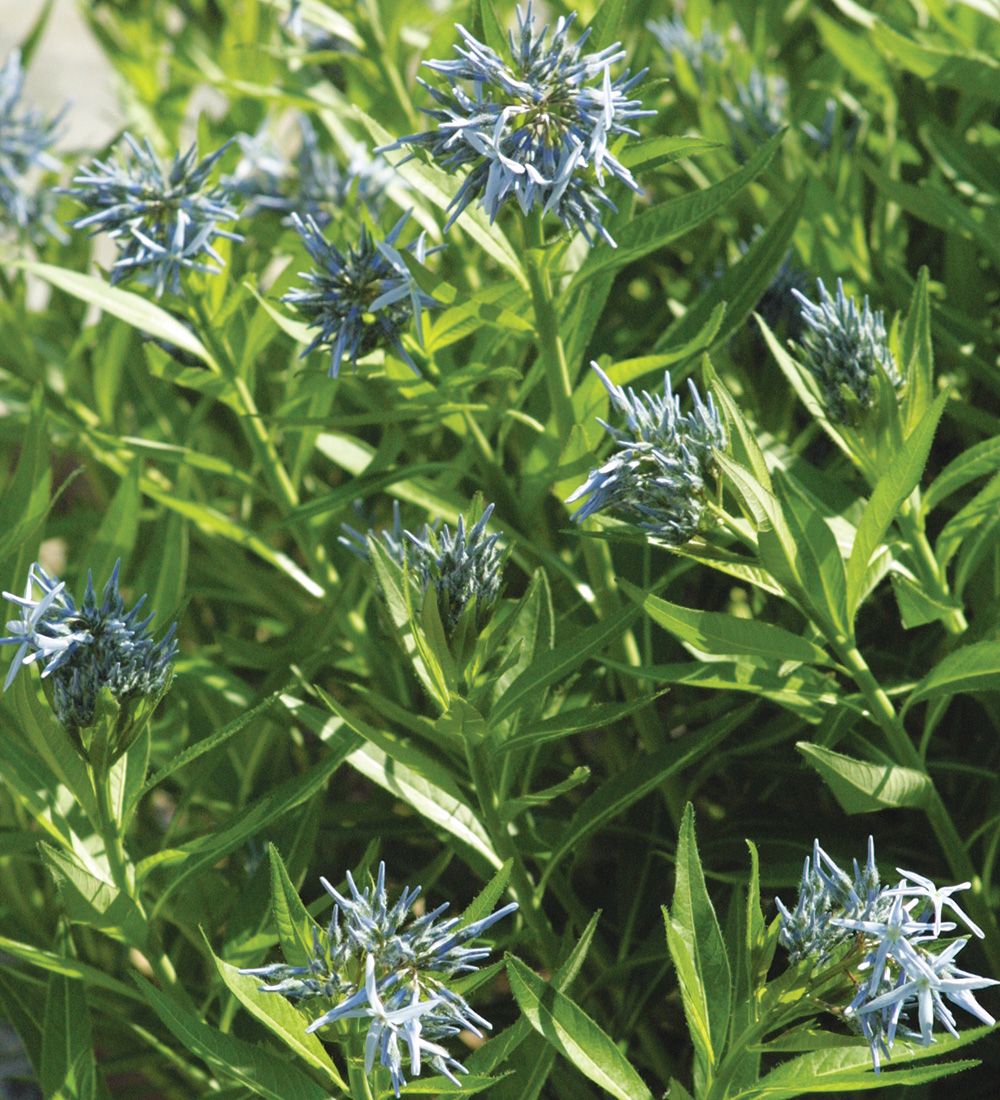
Name: Amsonia tabernaemontana
Zones: 3–9
Size: Up to 4 feet tall and wide
Conditions: Full sun to partial shade; adaptable to a wide range of soil types
Native range: Mid-Atlantic and southeastern United States
I may have been skeptical when a salesperson first handed me a wispy little Arkansas bluestar (A. hubrichtii, Zones 4–9) and said, “You are going to love this!” But boy, was she right. At the time, I didn’t know the species was native to North America and had not yet discovered eastern bluestar, which is native to the Mid-Atlantic. Eastern bluestar has pale blue flowers and dark green, ovate leaves. It may not have the same wispy texture as its Arkansas cousin but will have a lovely, bushier form if it is cut back after flowering. It is equally deer resistant and can handle a dry spell once established. Although it will adapt to partial shade, it will have a more compact habit and fuller flowering in full sun.
Diablo® Ninebark
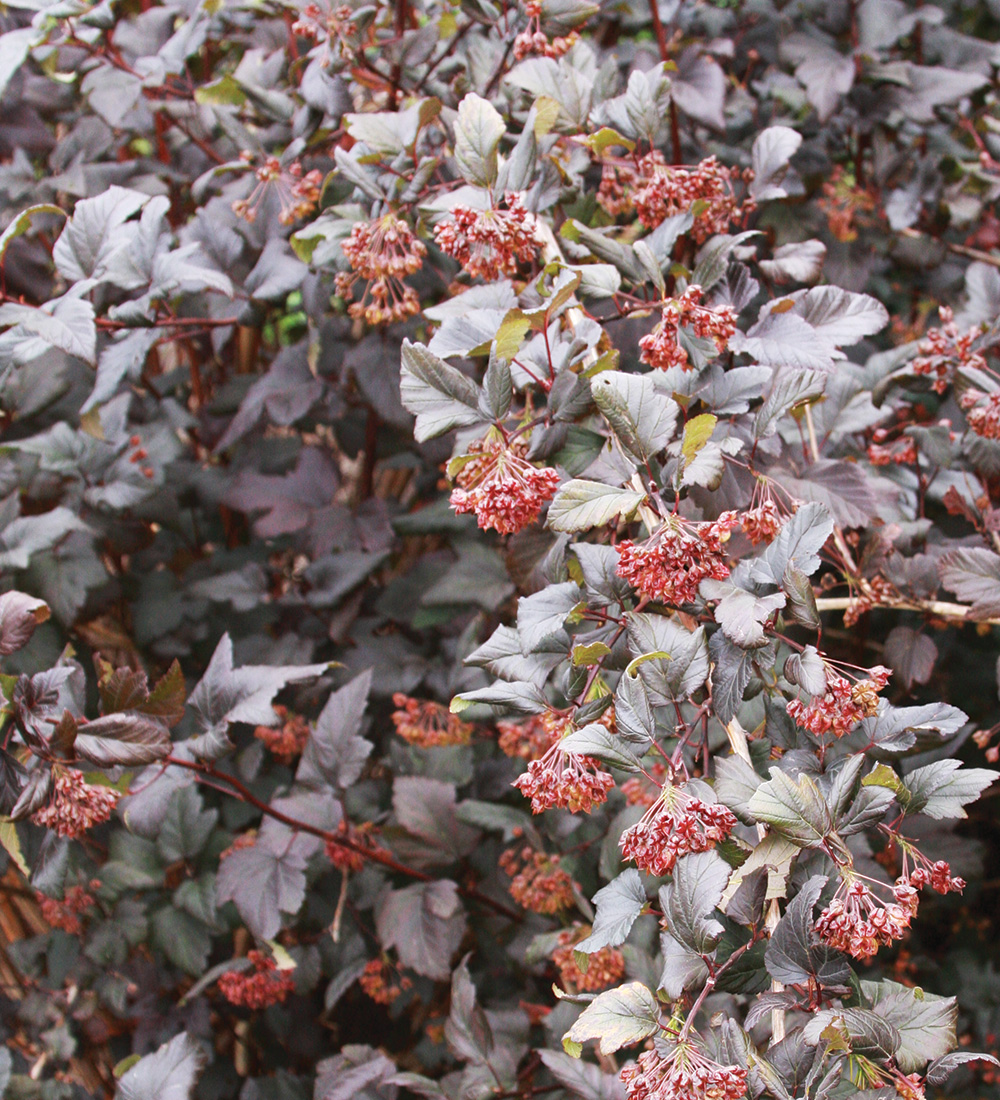
Name: Physocarpus opulifolius ‘Monlo’
Zones: 3–7
Size: 4 to 8 feet tall and wide
Conditions: Full sun to partial shade; well-drained soil
Native range: Eastern North America
Diablo® ninebark is a low-maintenance shrub that can handle a range of soil conditions, including amended clay. It is a great choice for replacing nonnatives like smokebush (Cotinus coggygria, Zones 4–8) and spirea (Spiraea spp. and cvs., Zones 3–9). Ninebark cultivars offer a variety of heights and foliage colors that run from near black to coppery orange, and these showy hues hold all season. I like to incorporate the deep purple foliage of Diablo® as a dark backdrop or a visual break among brighter plants. For a smaller dose of the same rich foliage color, try Little Devil™ (P. opulifolius ‘Donna May’), which grows just 3 to 4 feet tall, or Tiny Wine® (P. opulifolius ‘SMNPOTW’), which will top out at 4 to 5 feet tall and wide.
‘Southern Comfort’ Heuchera
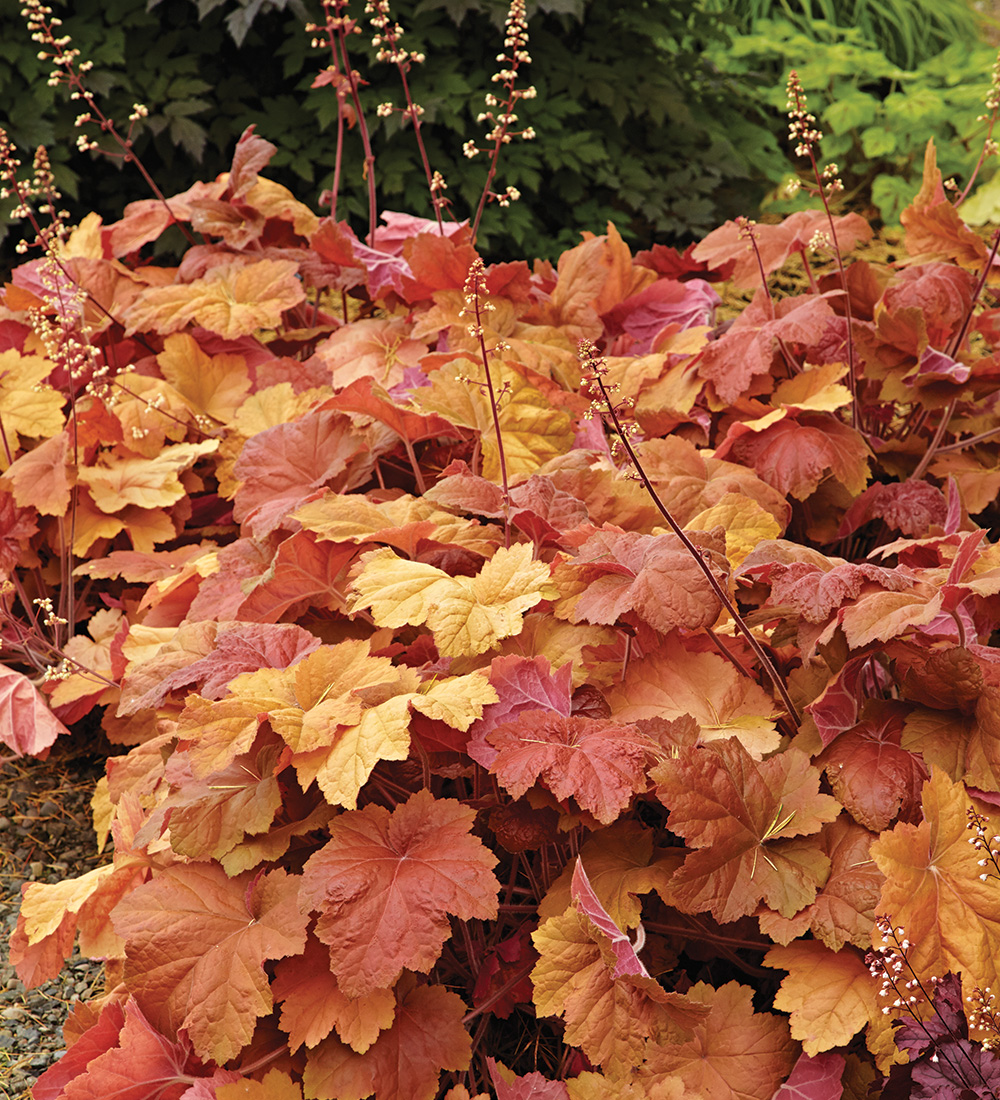
Name: Heuchera ‘Southern Comfort’
Zones: 4–9
Size: 12 to 24 inches tall and 12 to 18 inches wide
Conditions: Full sun to partial shade; moist, well-drained soil
Native range: Eastern to central North America
Flowers are fleeting, so why not let colorful foliage like that of ‘Southern Comfort’ anchor your multiseason garden? Masses of heucheras with purple, lime, or orange leaves provide a persistent base that will make the colors of other plants pop. Cultivars with lighter foliage tend to do better in sun than the darker ones, and peachy ‘Southern Comfort’ is my favorite. It is semi-evergreen, needing just a bit of tidying in spring, and my plants have color all season in Zone 7. Heucheras prefer moist, fertile soil but can handle some drought. Their flexible light requirements make them useful for tying disparate beds together with one unifying hue.
Culver’s Root
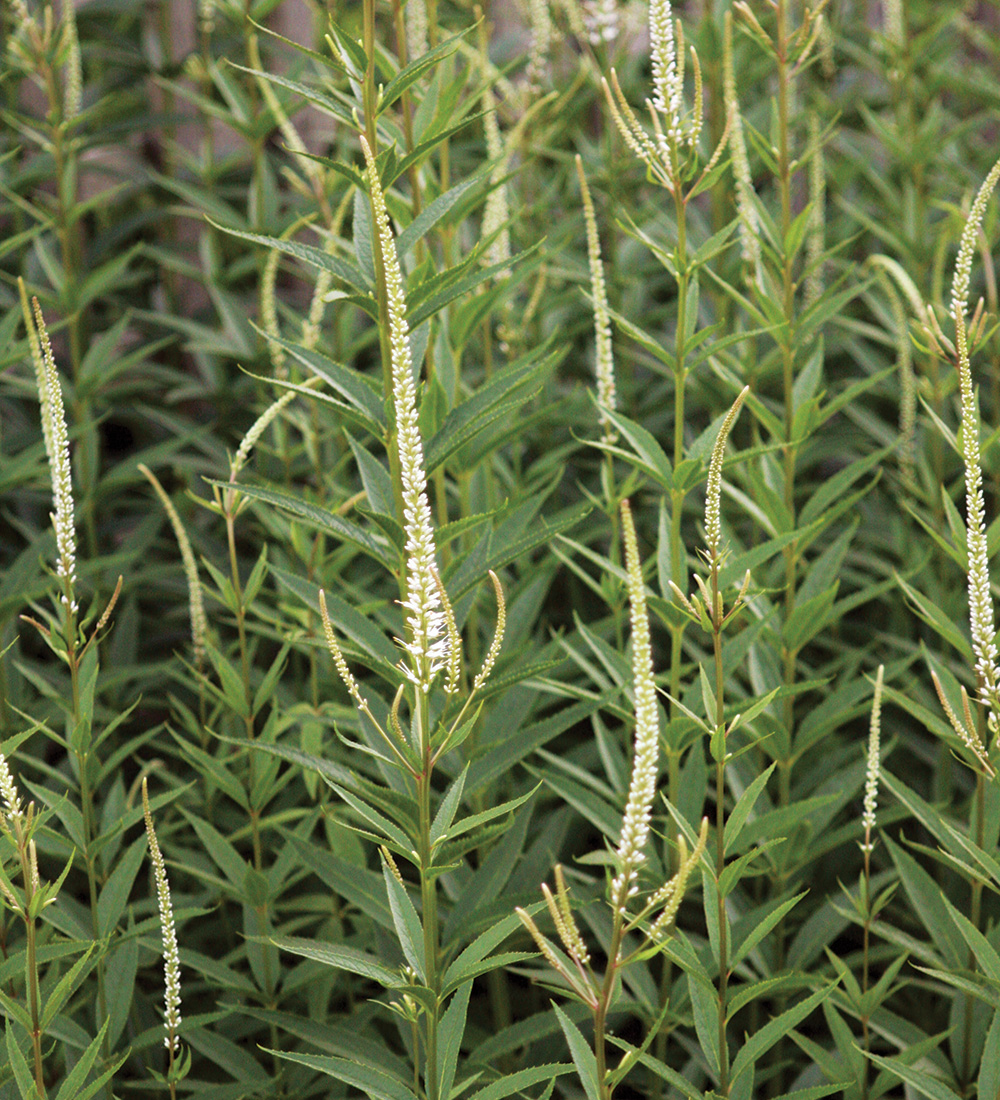
Name: Veronicastrum virginicum
Zones: 3–8
Size: 4 to 7 feet tall and 2 to 4 feet wide
Conditions: Full sun to partial shade; moist, well-drained soil
Native range: Eastern North America
The biggest outdoor design trend in recent years has been moving away from manicured gardens toward a more naturalistic look. I recently installed a meadow planting that takes up the entire 2,500-square-foot front yard of a suburban home. Culver’s root works magic in this setting, where its breathtaking beauty and multiple seasons of interest add unexpected curb appeal. Its candelabra- like architecture and towering height make it an interesting counterpoint to lower-growing flowers and grasses. It needs moist soil, which makes it perfect for planting at the woodland’s edge. Like bluestar, Culver’s root will tolerate partial shade but gets floppy without enough sun.
Regional expert: Caitlin Boyle, a landscape designer and writer, is the owner of Dirt Diva Designs in Chatham, New Jersey. She is also a Mid-Atlantic regional reporter for FineGardening.com.
Northeast
Wild Geranium
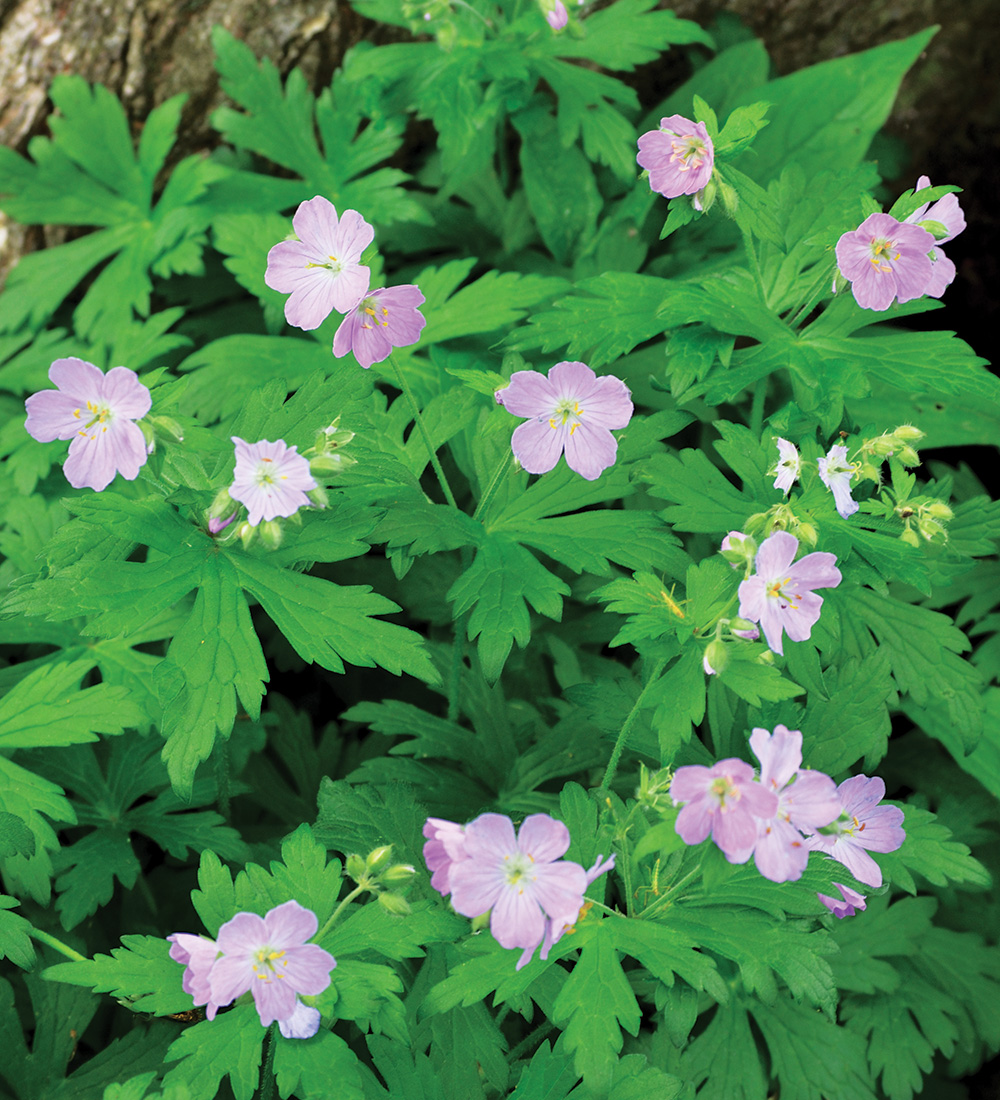
Name: Geranium maculatum
Zones: 3–8
Size: 1 to 2 feet tall and wide
Conditions: Full sun to partial shade; rich, moist, well-drained soil
Native range: Eastern North America
It’s easy to pick out wild geranium’s bright lavender to pink flowers in spring along roadsides throughout the Northeast, and no shade garden in our region seems complete without them. This plant will naturalize easily in moist woodland settings, though it can be tricky to intentionally grow from seed, so start your patch with plugs or larger plants. Pair it with other robust spring natives such as golden ragwort (Packera aurea, Zones 3–8), wood poppy (Stylophorum diphyllum, Zones 4–9), or Virginia bluebells (Mertensia virginica, Zones 3–8) in areas where you don’t mind letting nature take over. It works equally well in more formal settings where it makes a good companion for hostas (Hosta spp. and cvs., Zones 3–8).
Showy Goldenrod
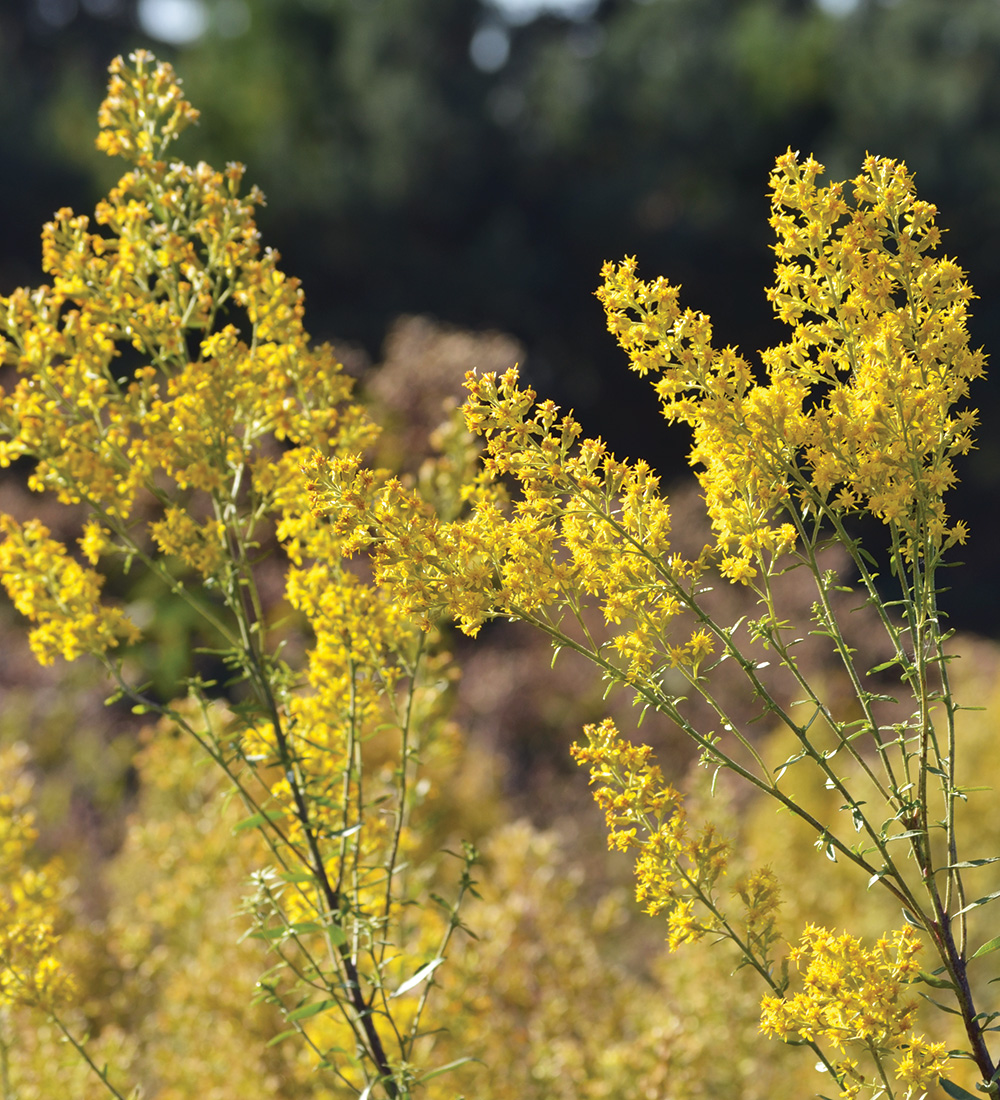
Name: Solidago speciosa
Zones: 3–8
Size: 2 to 3 feet tall and wide
Conditions: Full sun; dry to medium, welldrained soil
Native range: Central and eastern North America
Sometimes a name says it all, and showy goldenrod is showy indeed. Think loud forsythia-yellow, but late in fall, so you can combine it with red autumn foliage and tawny grasses. In addition to its vibrant plumes of color, it has an upright and sturdy habit, making it tidier and more garden-worthy than many other goldenrods. It’s also much better behaved and less aggressive but benefits from an early summer cutback to ensure it stays stout and bushy, especially in richer soil or less than full sun, conditions that tend to make it flop. I like to plant showy goldenrod en masse to fully appreciate its electric-yellow flowers, but even as a specimen, this perennial is a winner.
Hairy Penstemon

Name: Penstemon hirsutus
Zones: 3–9
Size: 1½ to 3 feet tall and 1 to 1½ feet wide
Conditions: Full sun to full shade; welldrained soil
Native range: Eastern North America
Hairy penstemon, or hairy beardtongue, has a silly name that delights kids, fuzzy-throated flowers that delight bees, and an agreeable habit that delights gardeners. Blooming with pale lavender flowers in late spring, which is earlier than other penstemons, it handily fills the bloom gap between spring and summer natives. It’s a trouble-free, casually beautiful, enthusiastic addition to any garden. Herbivores leave it alone, and it grows with ease in a variety of conditions. Quick to flower, fall seedlings bloom the following spring from a rosette of dark green and often purple-tinged leaves. This plant cheerfully self-sows, and I let the yearly volunteers bloom before I thin out their legions. Cut stems to the ground after flowering to revitalize the attractive foliage.
Closed Bottle Gentian

Name: Gentiana andrewsii
Zones: 3–7
Size: 1 to 2 feet tall and wide
Conditions: Full sun to partial shade; moist, rich, welldrained soil
Native range: Northeastern North America
Closed bottle gentian is a fascinating and beautiful perennial with an air of rarity. The flowers are unusual both for their bright blue coloring late in the season and for the fact that they never truly open! Only bumblebees and hummingbirds have the brawn to make their way between the petals to the nectar, and their efforts make for an entertaining fall show. Both this and the very similar bottle gentian (G. clausa, Zones 3–9) are native to New England and do best in our cooler zones but will tolerate warmer areas better when given moist and rich growing conditions. Once established, this special plant will slowly spread to grace your garden for years to come.
Regional expert: Chloë Bowers has worked as a gardener and landscape designer for 20 years. She lives and gardens in Newtown, Connecticut, and is also a Northeast regional reporter and forum moderator for FineGardening.com.
Regional expert photos: courtesy of the contributors.
Fine Gardening Recommended Products
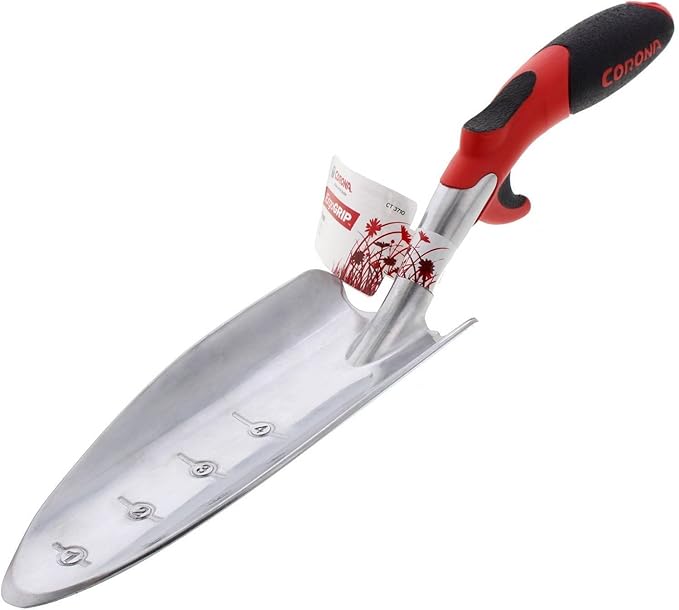
Corona E-Grip Trowel
Fine Gardening receives a commission for items purchased through links on this site, including Amazon Associates and other affiliate advertising programs.
Handle Material: Aluminum. Handle Length: 14-1/2 in. Overall Length: 14.5 in. Head Material: Aluminum. Handle Color: Red.
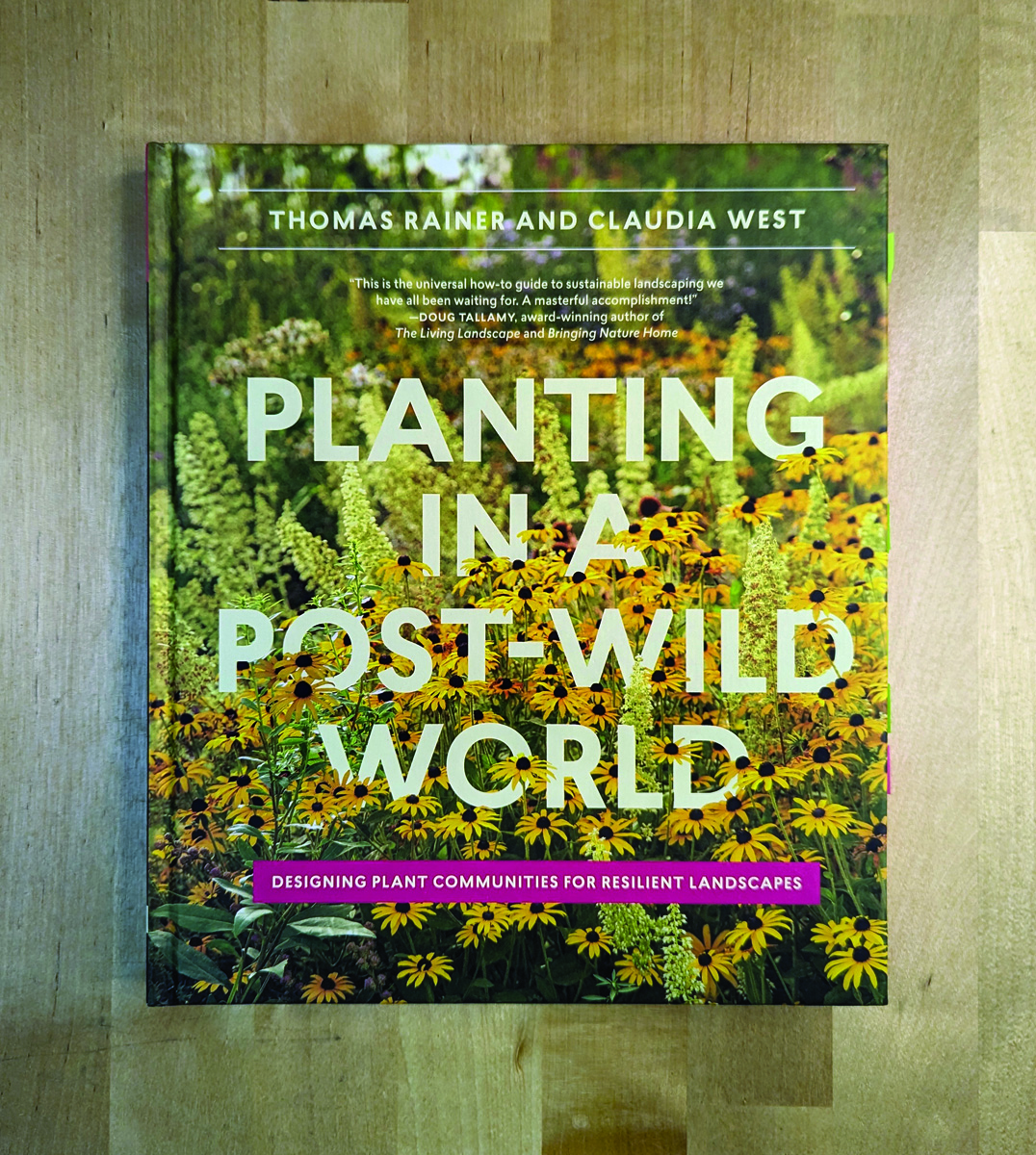
Planting in a Post-Wild World: Designing Plant Communities for Resilient Landscapes
Fine Gardening receives a commission for items purchased through links on this site, including Amazon Associates and other affiliate advertising programs.
Featuring gorgeous photography and advice for landscapers, Planting in a Post-Wild World by Thomas Rainer and Claudia West is dedicated to the idea of a new nature—a hybrid of both the wild and the cultivated—that can nourish in our cities and suburbs.
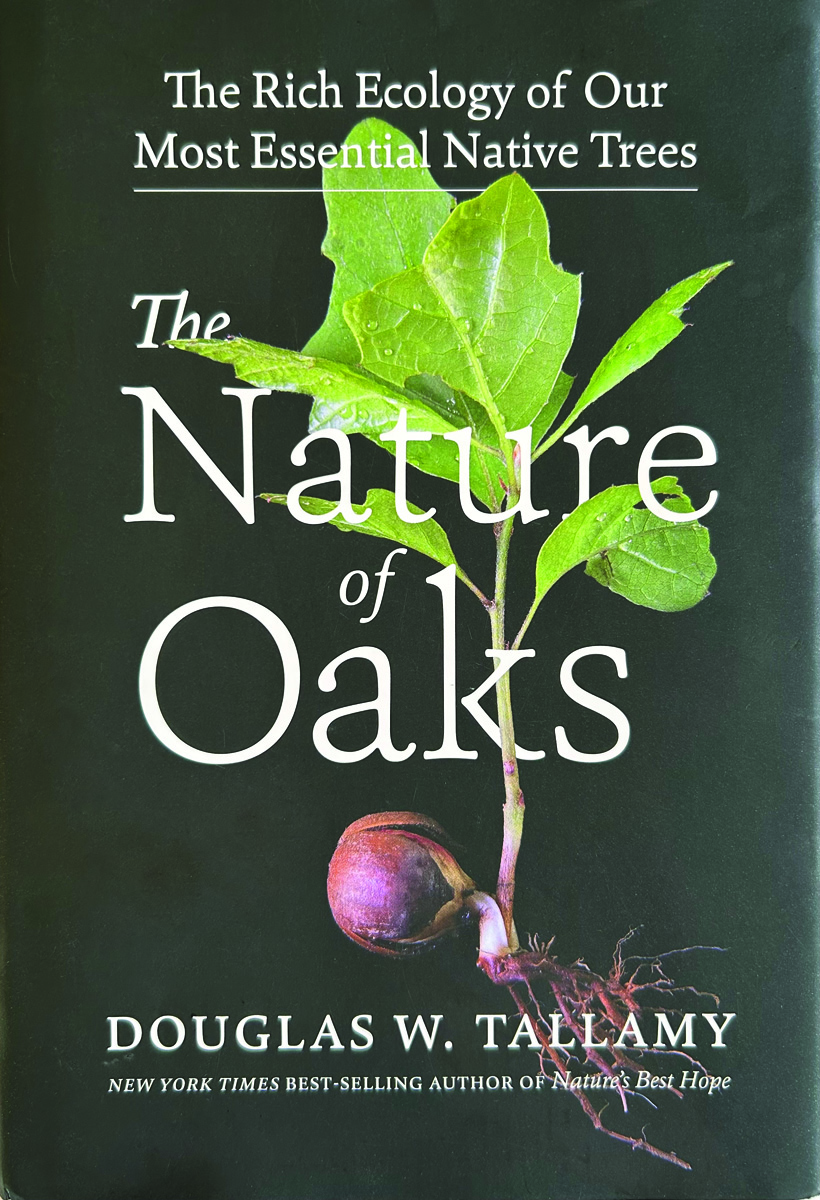
The Nature of Oaks: The Rich Ecology of Our Most Essential Native Trees
Fine Gardening receives a commission for items purchased through links on this site, including Amazon Associates and other affiliate advertising programs.
The Nature of Oaks reveals what is going on in oak trees month by month, highlighting the seasonal cycles of life, death, and renewal. From woodpeckers who collect and store hundreds of acorns for sustenance to the beauty of jewel caterpillars, Doug Tallamy illuminates and celebrates the wonders that occur right in our own backyards. He also shares practical advice about how to plant and care for an oak, along with information about the best oak species for your area.

